Astronomy Object of the Month: Archive
| January: Multiphase magnetic fields in the galaxy NGC 3627 |

|
Magnetic fields play an important role in the formation and evolution of a galaxy, but it is challenging to measure them by observation. Leo Triplet member NGC3627 was a subject of determining magnetic field orientation via Velocity Gradient Technique (VGT) using spectroscopic data. The agreement of the VGT-CO and polarization suggests that the magnetic fields associated with synchrotron emission also percolate through star-forming regions. The VGT-Hα measurement reveals the magnetic fields in the warm ionized medium that permeates the disc and disc’s vicinity so that it exhibits less agreement with polarization. Więcej... |
| December: 4C70.19 - a very twisted radio galaxy |
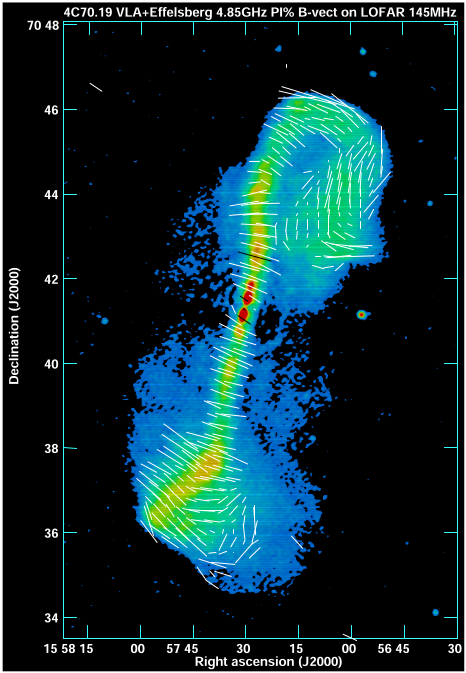
|
Radio galaxies are typically associated with an active galactic nucleus (AGN) in the centre of an elliptical or sometimes spiral galaxy, that emits a powerful jet of particles extending over tens to hundreds of kiloparsecs (kpc) or even up to several megaparsecs (Mpc). Interacting with the surrounding intergalactic medium (IGM) these jets form a variety of shapes, lobes or plumes, depending on the initial energy and the properties of the medium through which they travel. Sometimes, the produced shapes make it difficult to associate the radio galaxy to a known class of objects. 4C70.19 is a great example. More... |
| November: A New Effective Method for Analyzing Extremely Low-Frequency Electromagnetic Waves |
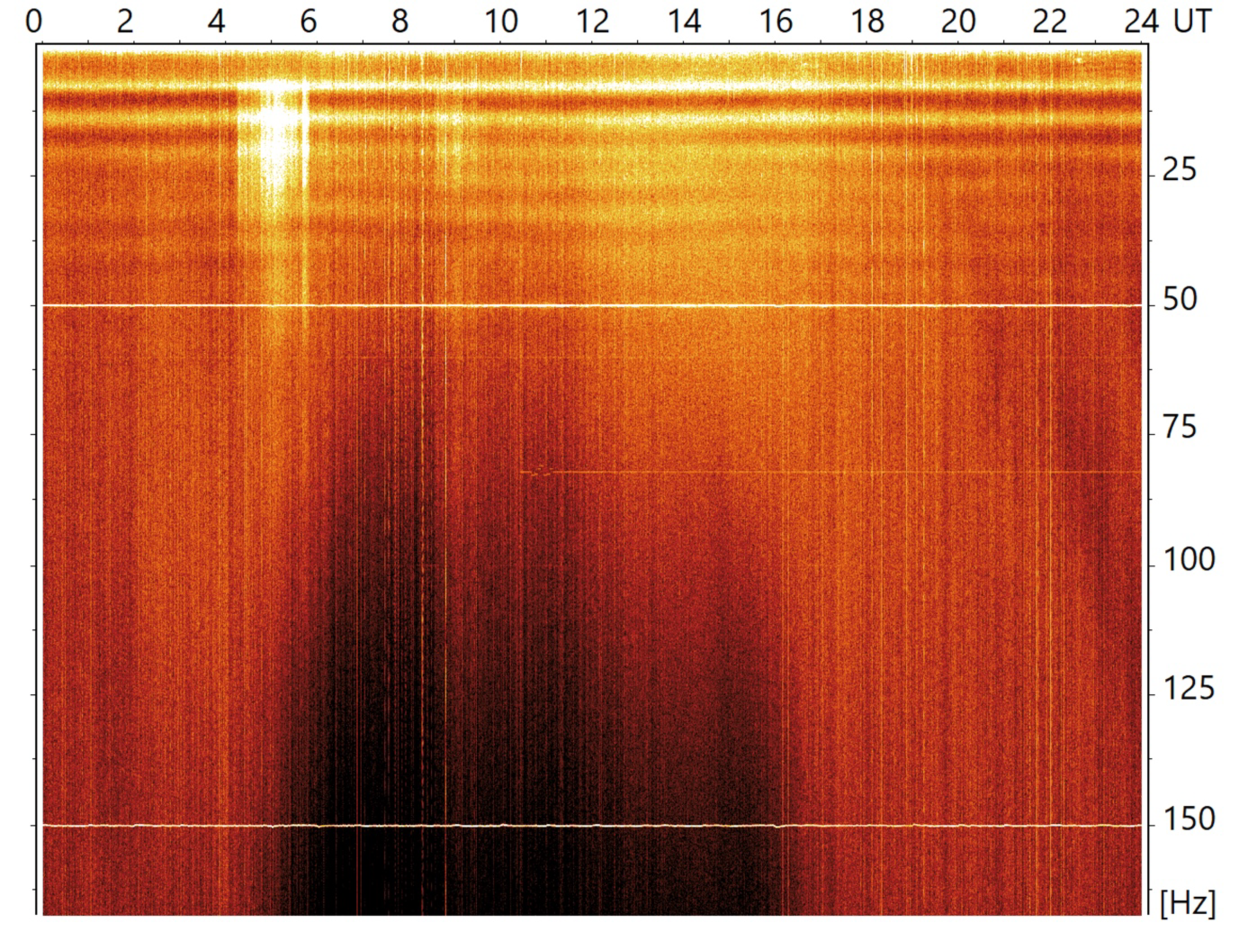
|
Extremely low frequency electromagnetic waves (ELF; here from 0.03 to 1000 Hz) propagating in the spherical resonant cavity between the Earth's surface and the ionosphere provide an effective means of testing the ionosphere's state and its inhomogeneities. They allow for the analysis of solar activity impacts in the UV and X-ray range, solar flares, and space weather. Additionally, they enable studies of such terrestrial phenomena of importance as climate change. Analysis of ELF waves is also crucial for mitigating possible coherent electromagnetic interference in gravitational wave detector networks, like LIGO-VIRGO-KAGRA. Our new measurements from the ELA11 station in the Bieszczady Mountains offer promising potential for advancing such research. Here, we present the first in a series of studies conducted over the past year based on data from this station. More... |
| October: J0644+1043: A Giant Cosmic Serpent |
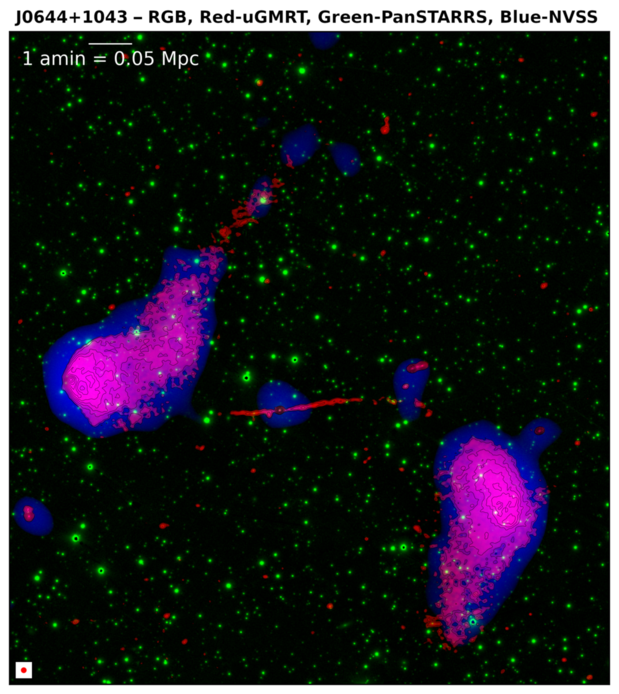
|
Highly sensitive radio observations obtained using Giant Metrewave Radio Telescope (GMRT) led to the unusual discovery of a 100 kpc narrow curved twin jet in the S-shaped giant radio galaxy J0644+1043. More... |
| September: Strange galactic microquasar SS 433 |

|
The H.E.S.S. observatory in Namibia has detected high-energy gamma rays coming from the plasma jets of the SS 433 microquasar, and pinpointed the exact location within them of one of the galaxy's most efficient particle accelerators. By comparing gamma-ray images at different energies, it was possible for the first time to estimate the speed of the jet away from its emission site. This enabled to identify the mechanism that so effectively accelerates the particles. More... |
| August: Observations of a smaller black hole in OJ 287 and its jet |
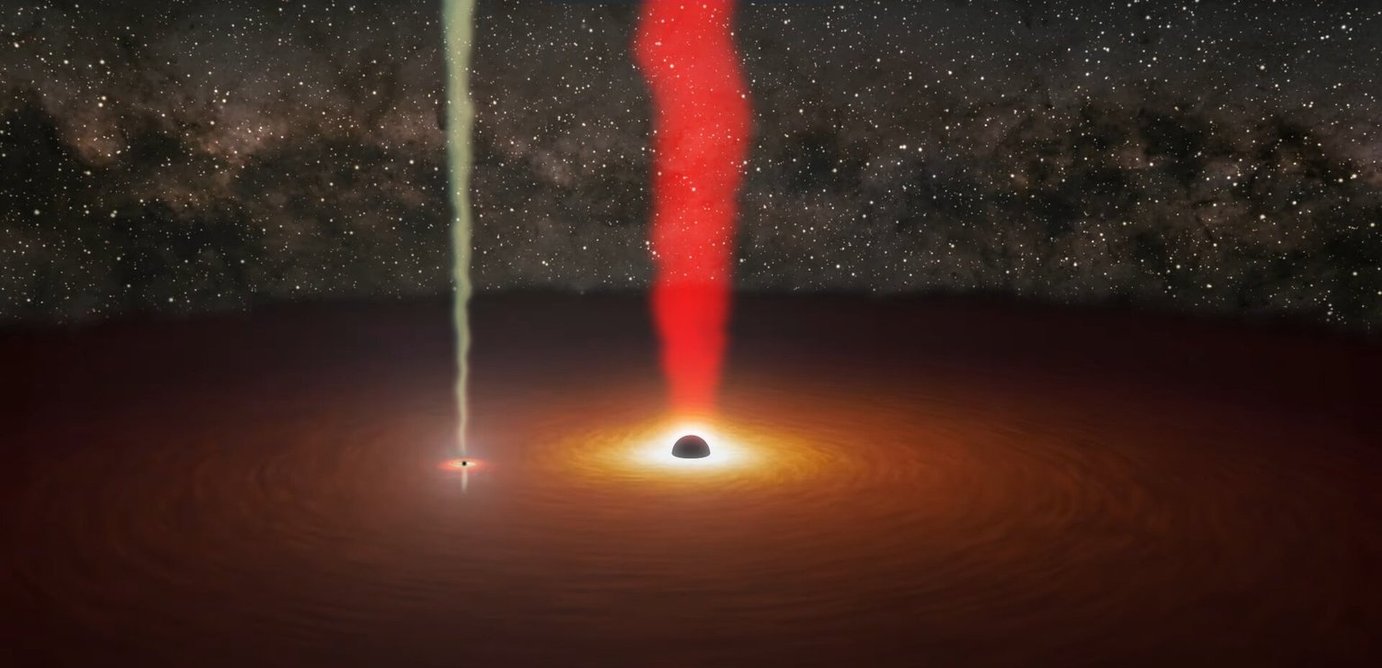
|
Several collaborating research groups, including a team from the Jagiellonian University, have confirmed the presence of two supermassive black holes in the active nucleus of the distant galaxy OJ 287. The existence of a pair of black holes was first suggested by astronomers from the University of Turku, Finland, back in 1982. More... |
| July: Panchromatic SED modeling of infrared bright galaxies |

|
The field of galaxy formation and evolution has undergone a revolutionary transformation over the past two decades, facilitated by abundant data collected from multiwavelength photometric and spectroscopic surveys. These observations play a crucial role in understanding the star formation history of the Universe, determining the redshift of the first proto-galaxies, and tracing the evolutionary processes of small components into the massive galaxies observed today. More... |
| June: Swift Satellite and AI unravel the distance of the farthest Gamma-Ray Bursts |
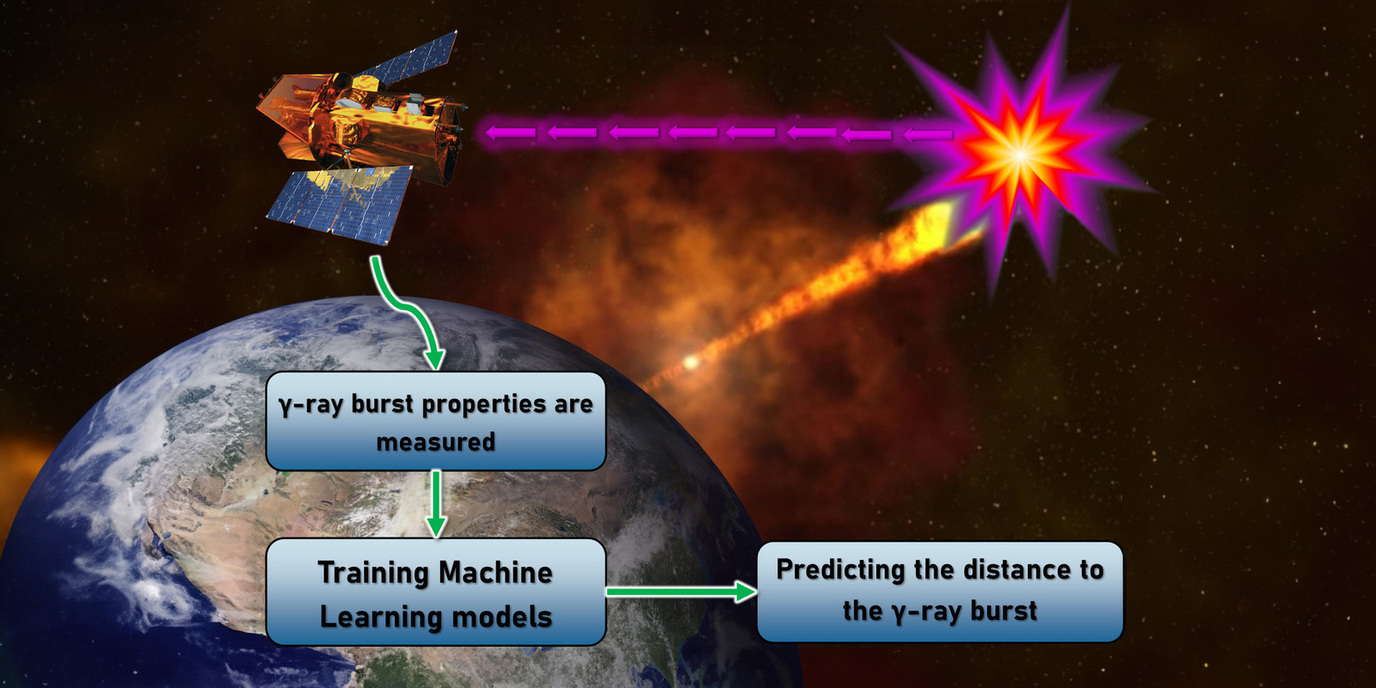
|
An international team of astrophysicists has developed a novel machine learning technique to measure the distance to gamma-ray bursts, the most powerful explosions in the universe. The result was published in the Astrophysical Journal Letters (ApJL) and the Astrophysical Journal Supplement Series (ApJSS). The lead authors of these works are Dr. Maria Dainotti (Japan, NAOJ) and Mr. Aditya Narendra from the Astronomical Observatory of the Jagiellonian University, Poland. More... |
| May: Chaos and Einstein-Rosen Gravitational Waves |

|
In 2015, the first detection of gravitational waves was made. Now, nine years later, gravitational wave astronomy is a rapidly growing field. We have learned to observe the Universe in a previously unknown way. More... |
| April: Multi-wavelength diagnostics of the Molecular Cloud, DC 314.8-5.1 |
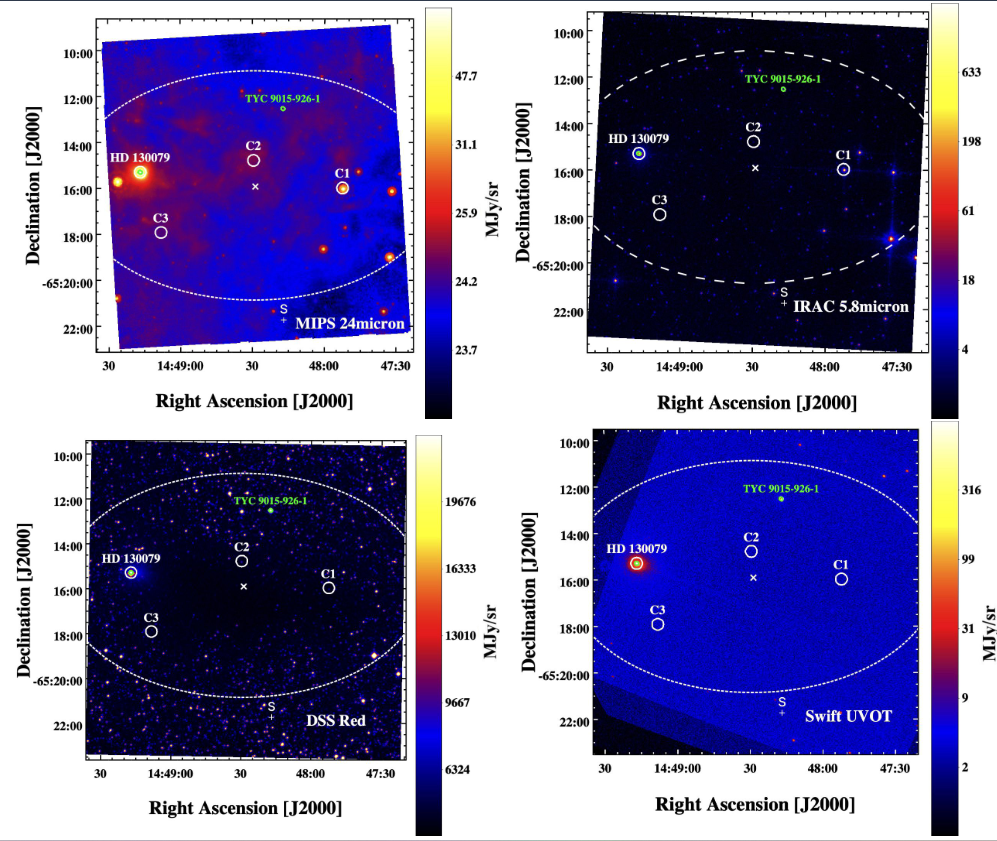
|
An international team of astronomers led by researchers at the Jagiellonian University Astronomical Observatory, study the multi-wavelength characteristics of the interstellar medium, probing the stellar populations within the dark cloud, DC 314.8-5.1. The team utilized data from the Gaia optical, 2MASS near-infrared, and WISE mid-infrared surveys, dedicated imaging with the Spitzer Space Telescope, and X-ray data obtained with the Swift-XRT Telescope (XRT). More... |
| March: Classification of galactic mergers with convolutional neural networks |
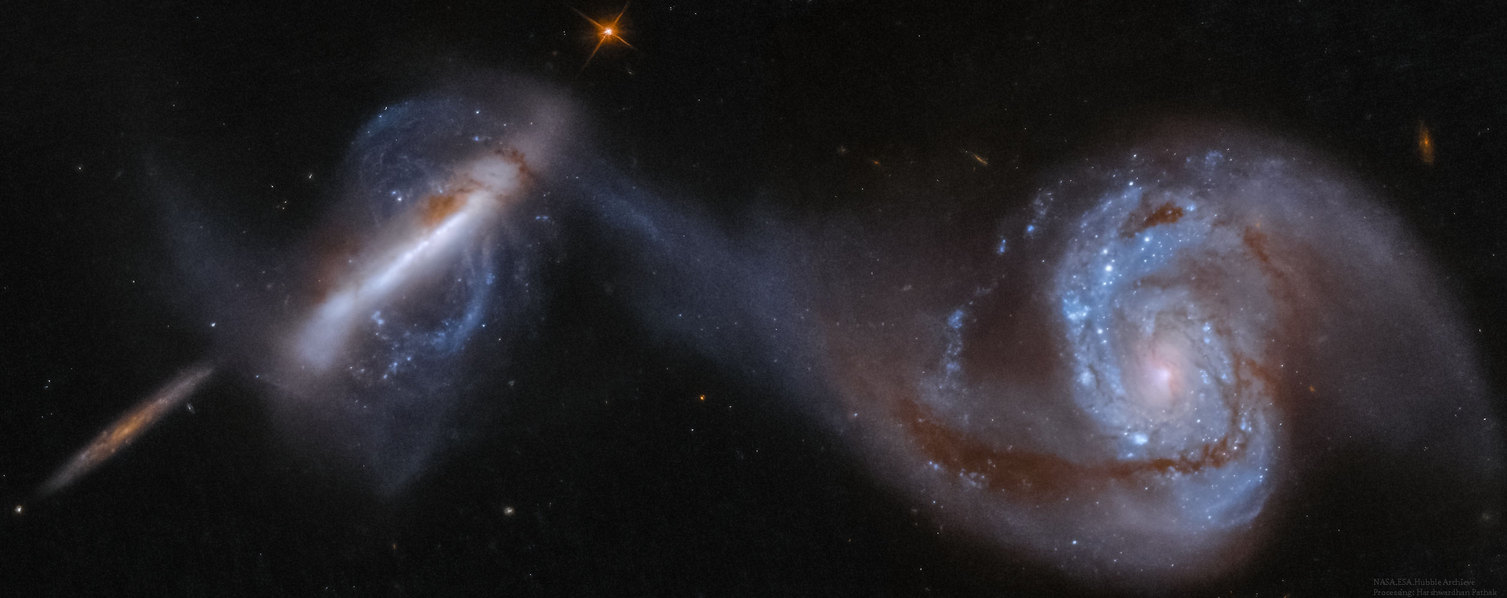
|
Lambda-CDM cosmology assumes that galaxies form by hierarchical mergers of smaller structures, so mergers of galaxies provide astronomers with crucial information about the evolution of galaxies over time. More... |
| February: Pulsar and gamma rays with record energy |

|
Astrophysicists at the H.E.S.S. Observatory in Namibia have discovered the highest energy gamma rays ever from the Vela pulsar. The energy of the photons of this radiation reaches 20 teraelectronvolts, which is as much as ten trillion times the energy of photons in visible light. As reported by the international team, which included astronomers from Jagiellonian University in Kraków, these observational results are difficult to reconcile with the current theory of the formation of high energy gamma rays in pulsars. More... |
| January: PSR B0809+74 – a drifting subpulse pulsar reveals the secrets of the emission mechanism |

|
Pulsars are fast-rotating neutron stars endowed with a very strong magnetic field. While more than 55 years have passed since their discovery, the mechanism responsible for their radiation still remains mysterious. More... |
| December: Covered Quasars |

|
Quasars are some of the brightest objects we know in the Universe. Although they were originally thought to be near stars,
we now know that they are galaxies with a very bright source at the center – a super-massive black hole that accretes (absorbs)
such large amounts of matter that some of it is converted into energy, to which the entire galaxy owes its extraordinary
brightness. Thanks to their brightness, we can observe quasars that are very far away from us. This allows us to try to create
universal relationships that can be used to measure cosmological parameters (coefficients that help determine the geometry of the
Universe). At first, however, such a relationship must be calibrated, that is, it is necessary to know what exactly can affect it.
More... |
| November: Thunderstorms on Earth and gravitational wave detection |

|
Electromagnetic waves of extremely low frequencies (0.03 Hz – 300 Hz; ELF) measured by a team from Astronomical
Observatory of the Jagiellonian University are mainly generated by electrical discharges in storm centres around the world
and — before they are dumped — encircle the Earth globe several times in a spherical resonance cavity forming between the
Earth's surface and the ionosphere. What significance do they have for measurements of gravitational waves — in a similar
frequency range — with LIGO interferometers in the USA, VIRGO in Italy, and, from this year, also Kagra in Japan?
More... |
| October: What do halo CMEs tell us about Solar Cycle 25? |

|
The Sun affects the Earth’s environment in a variety of ways and different time scales. It powers life on Earth, therefore
any changes in the radiative output of the Sun may affect the energy balance on our planet. Satellite observations over the
past 40 years have shown that long and short-term variations in solar activity cause small changes to the Sun's energy output
(solar irradiance), less than 0.1%. Solar irradiance changes of this magnitude have no significant effect on our climate.
However currently, the Sun experiences a decline in activity. This may mean that the Sun enters a long period of low activity, a modern grand minimum.
More... |
| September: Rewriting the Past and Future of the Universe |

|
New research has improved the accuracy of the parameters governing the expansion of the Universe. More accurate parameters will help astronomers determine how the Universe grew to its current state and how it will evolve in the future.
More... |
| August: Reorientation of jets as a result of collision of galaxies |

|
This Astronomical Object of the Month describes the study of the X-shaped radio galaxy J1159+5820. The authors explain that
the reason for this strange structure may be the specific behavior of the supermassive black hole interacting with its disturbed
environment during the merger of galaxies that formed the host galaxy CGCG292-057.
More... |
| July: Finally, we have direct evidence of a pair of black holes at the center of the galaxy OJ 287 |

|
Scientists, including a team of Professor Stanislaw Zola from the Jagiellonian University's Astronomical Observatory in Krakow, Poland, are not stopping their studies of the active galaxy OJ 287. The results of the international team led by Professor Mauri Valtonen from the University of Turku (Finland), announced at the 242nd meeting of the American Astronomical Society and described in the latest issue of the scientific journal Monthly Notices of the Royal Astronomical Society, bring startling information on the detection of a signal generated by a second supermassive black hole located at the center of this distant galaxy.
More... |
| June: Radio luminosity distribution in early-type galaxies |

|
Is radio luminosity distribution in early-type galaxies bimodal, and what does it imply? The radio emission is produced
predominantly when the relativistic plasma particles are accelerated in strong magnetic fields. Such conditions can be
found in the regions of intense starformation - where supernovae can be found or in the galaxy's center, which is the
locus of a supermassive black hole. From the vicinity of the black hole, plasma and magnetic field are transported to
distances far larger than the host galaxy's size as they create extended structures: jets and radio lobes.
More... |
| May: The cosmological model with a second-order perturbations |

|
The standard cosmological model is given by the Friedmann-Lemaitre-Robertson-Walker solution. It explains many aspects of the observed Universe. However, the success of this model is accompanied by some mysteries and problems to be solved. The model predicts the existence of unknown, hypothetical forms of matter like dark matter and dark energy.
More... |
| April: Gravitational lensing of blazar S5 0716+714 |
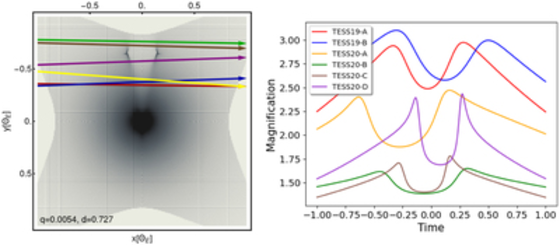
|
Blazars are a class of active galaxies whose jets (relativistic streams) are directed toward an Earth-based observer. They are characterized by high variability in luminosity, observed in various ranges of electromagnetic radiation, from radio to gamma rays, and on different time scales – from minutes to tens or even hundreds of years.
More... |
| March: Periodic Oscillations in LASCO Coronal Mass Ejection Speeds: Space Seismology |
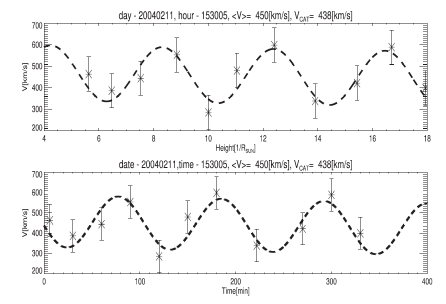
|
Coronal mass ejections (CMEs) are energetic expulsions of organized magnetized plasma from the Sun. They are intensively studied because of their significant impact on Earth. The first CME was discovered in 1971 using the seventh Orbiting Solar Observatory (OSO-7). The longest series of observations have been carried out by the Large Angle and Spectrometric Coronagraph (LASCO) on board the Solar and Heliospheric Observatory (SOHO) mission.
More... |
| February: 13 years of monitoring the optical variability of quasars at OAUJ |
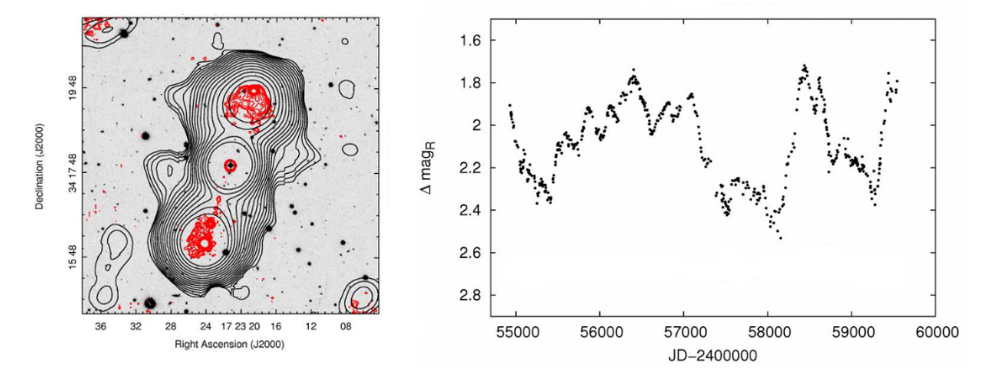
|
Active galaxies are some of the most energetic objects in the Universe. In their active nuclei (AGNs) processes of accretion of matter onto supermassive black holes occur, constituting a source of radiation over a wide range of the electromagnetic spectrum. They are also objects exhibiting radiation variability. Studying the nature of this observed variability, we can analyze the physical processes responsible for changes in the brightness of an active nucleus.
More... |
| January: Crisis in Cosmology: statistics on the rescue |
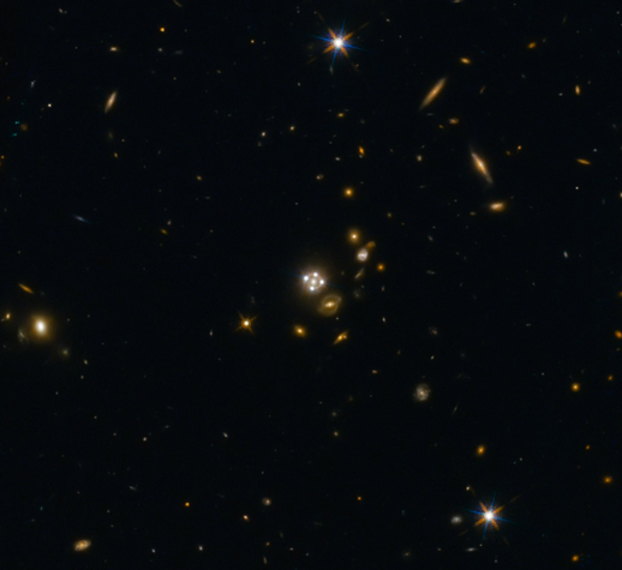
|
International team of scientists from Italy, Poland, and Japan has released a groundbreaking article with a solution to one of the biggest challenges of modern observational cosmology. A new statistical method was applied in order to remove the impact of selection biases on cosmological computations while avoiding circular reasoning. The article has been accepted for publication in The Astrophysical Journal Supplement Series.
More... |
| December: Twisted blazars |
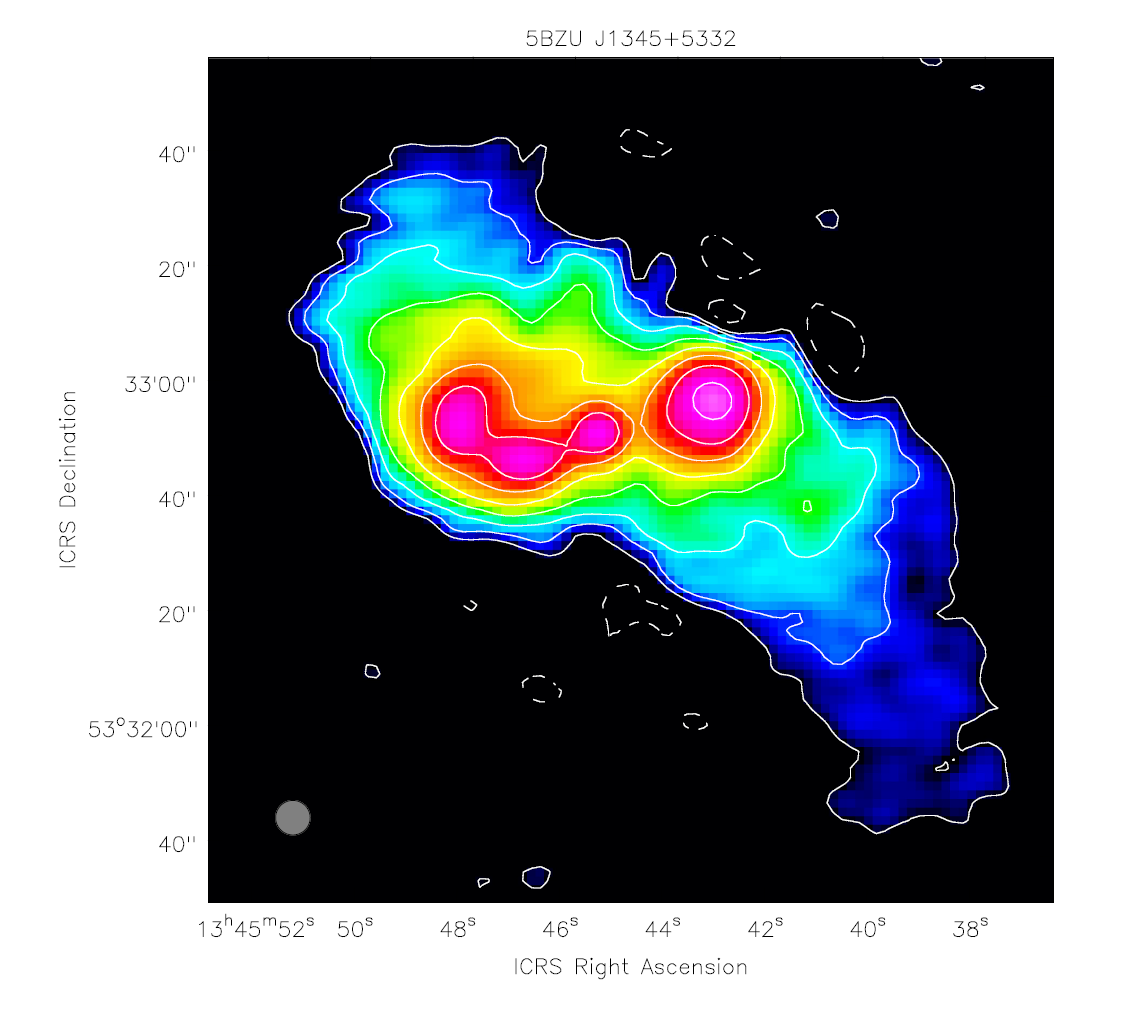
|
Astronomers from the Jagiellonian University Astronomical Observatory, with the help of dedicated and archival data from the European radio interferometer LOFAR, report a group of active galaxies with unexpected, extensive radio structures. Their analysis may provide new insight into past activity cycles of supermassive black holes residing at their centres.
More... |
| November: A bright and close blazar in X-rays — Markarian 421 |
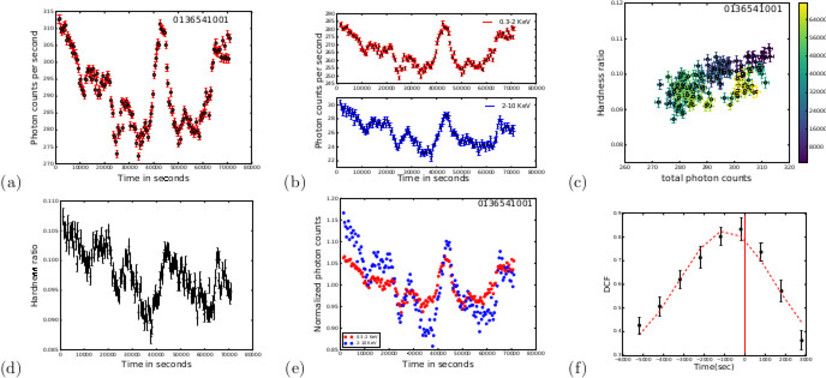
|
Blazars are a subclass of active galactic nuclei with relativistic jet facing the earth. These are variable in luminosity and spectra. Markarian 421 is a blazar that is highly luminous and variable, a high energy synchrotron peaked blazar with a featureless non-thermal spectra. It is one of the closest blazar with a redshift of 0.03 which gives approximately 134 Mpc. It is a highly energetic source which emits in the entire observable electromagnetic spectrum; the first extragalactic source that was observed to emit in TeV energy range in 1992. The source is variable at very short timescales of minutes to few hours, that is it displays intraday variability (IDV). The IDV phenomenon is one of the most puzzling one in blazars and yet to be completely understood. This is speculated to have a relation with the close surrounding of the supermassive black hole.
More... |
| October: AGNs and the machine learning algorithm |

|
A team of researchers lead by Maria Dainotti, Assistant Professor at the National Astronomical Observatory of Japan
(NAOJ), has achieved a tight correlation between the redshift values predicted by a machine learning algorithm and
the actual observed redshifts of powerful galaxies called Active Galactic Nuclei (AGNs). This is the first time that
redshifts for AGNs observed by the Fermi Gamma-Ray Space telescope have been estimated using machine learning
algorithms, and their results offer a fantastic avenue where the unknown redshifts of many AGNs can be reliably determined.
More... |
| September: Investigating the mysterious Luminous infrared Galaxies |
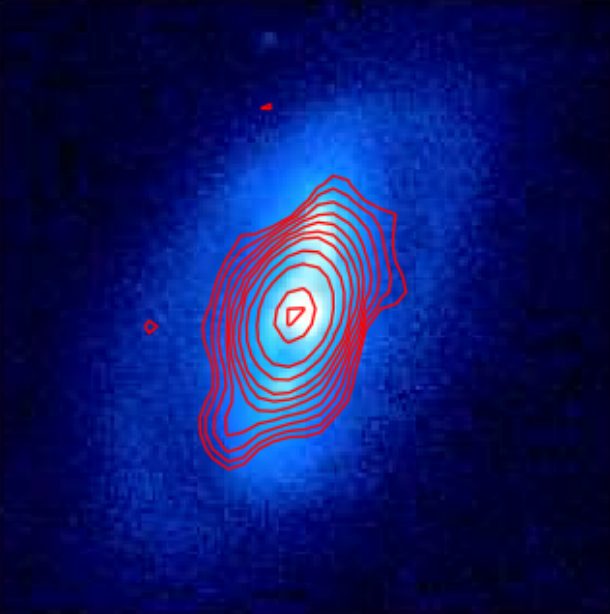
|
In the 1980s when Infrared Astronomical Satellite (IRAS)
was scanning the sky, it came across a few bright sources in the Infrared wavelength, which were too faint
to be detected in previous optical surveys. These galaxies were classified as Infrared galaxies. Luminous Infrared
galaxies, (LIRGs), as the name suggests are characterized by a prodigious amount of emission at infrared (IR)
wavebands (LIR > 1011 L☉). The bulk infrared emission in these galaxies is due to warm dust heated by active galactic
nuclei (AGN), starbursts, or both. These galaxies hence provide a unique laboratory to do a comprehensive study of star
formation and AGN activity.
More... |
| August: Subaru and Swift Gamma-Ray Bursts: a new optical 3D leap toward Standard Candles |

|
A new method to exploit Gamma-Ray Bursts (GRBs), the most energetic explosions in the universe, as independent measurements of the Universe’s expansion rate has been discovered in optical wavelength by an international team of 23 researchers led by Maria Dainotti, NAOJ Assistant Professor.
More... |
| July: M101 – a galaxy too large |
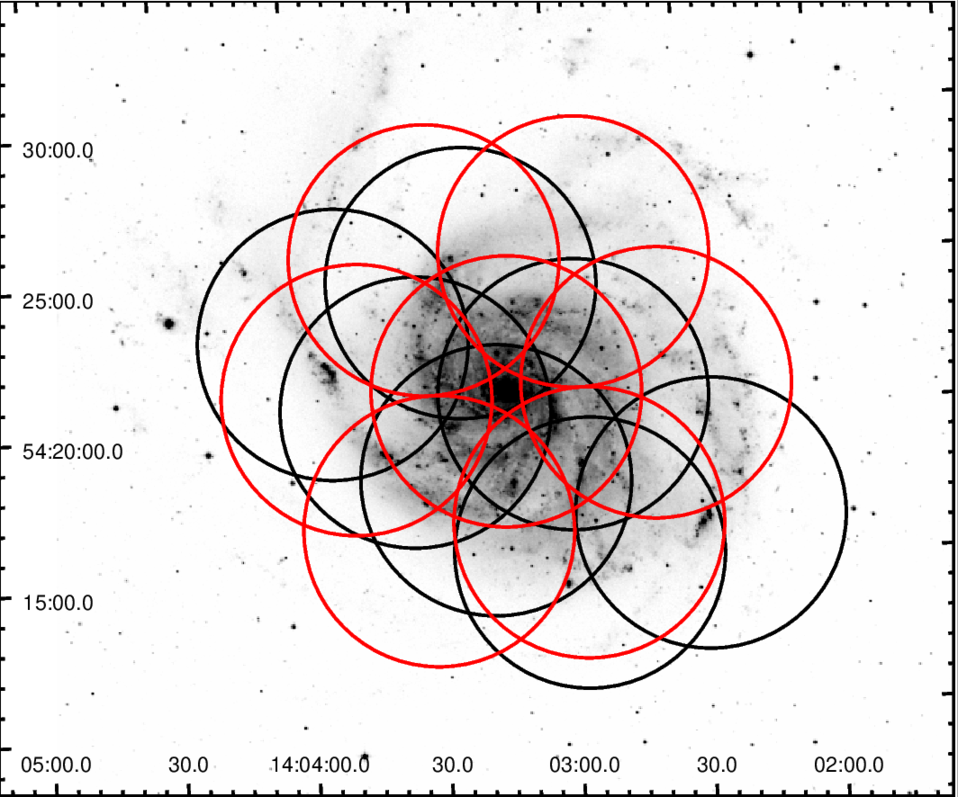
|
M101, also known to many sky enthusiasts as the Pinwheel Galaxy, is big, beautiful and... making troubles. Until recently, there were no radio observations of this galaxy at high frequencies that could provide a detailed view of its radio structure or give hints about its magnetic fields at smaller scales. The reason is that this galaxy is so large in the sky that it is difficult to be observed with radio interferometers.
More... |
| June: Cross-functional time servers at OAUJ |

|
High precision time measurement is necessary in many fields of astronomical research. This includes the analysis of optical radiation variability of stars and quasars conducted at OAUJ. Dedicated servers transferring time via the NTP protocol have been set up at
the Jagiellonian University Astronomical Observatory in Cracow for the precise time recording. It is a continuation of a long tradition of providing
time signal by the Cracow Observatory.
More... |
| May: New radio map revealing 4.4 million galaxies |
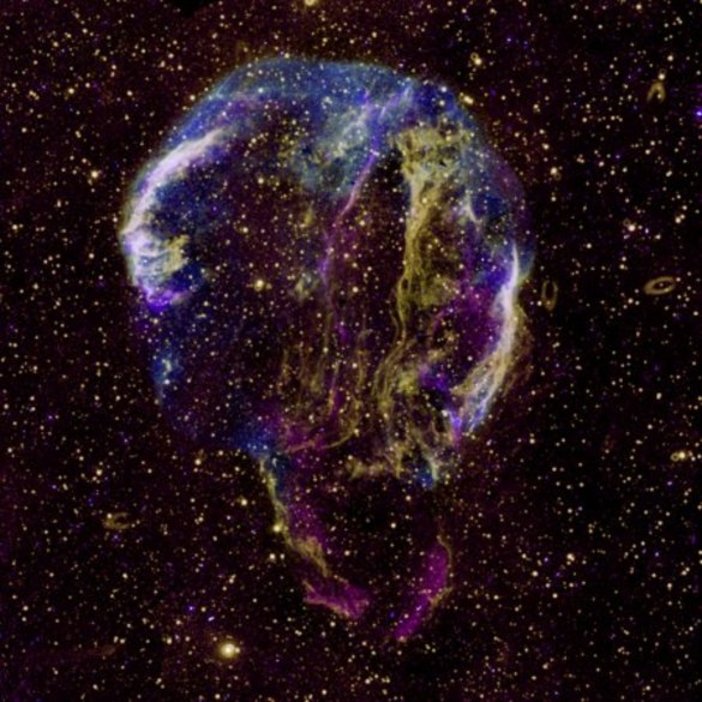
|
Over a seven year an international team including scientists from OAUJ has
mapped more than a quarter of the northern sky using the Low Frequency Array
(LOFAR), a pan-European radio telescope. It reveals an astonishingly detailed
radio image of more than 4.4 million objects and a very dynamic picture of
our Universe. This treasure trove of data is now public, so anyone can view the
most exotic wonders of our intriguing Universe in a new light.
More... |
| April: First Light of the SST-1M Cherenkov telescope at the Ondřejov Observatory |

|
On Wednesday, February 23, 2022, during its testing on the grounds of the observatory at the Astronomical Institute of the Czech Academy of Sciences in Ondřejov, one of the two SST-1M Cherenkov telescopes recorded its first events initiated by high-energy particles of both the hadronic origin and originating from gamma-ray photons.
More... |
| March: The history of the quasar HE 0435-5304 – the distance matters! |

|
Publicly available data is not too popular among scientific breakthrough seekers. Usually they were extensively researched and there is nothing more to discover. However, there are exceptions, such as the quasar HE 0435-5304, which sounds boring by name.
More... |
| February: Serpens: the star-forming region and UV riddle |
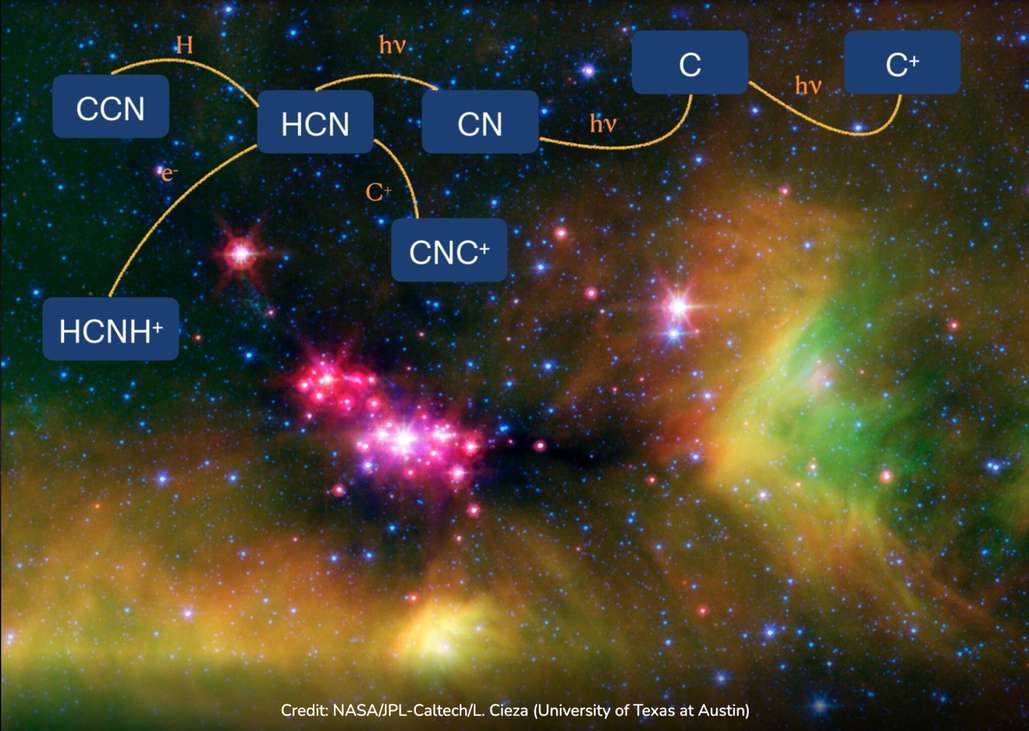
|
How does ultraviolet radiation influence the process of forming new stars and the entire planetary
systems? The topic remained largely unexplored until astronomers from UMK and UJ have decided to
take a closer look. The results they have achieved can provide more details concerning our origins
in space.
More... |
| January: Newly identified blazar candidates behind Magellanic Clouds |
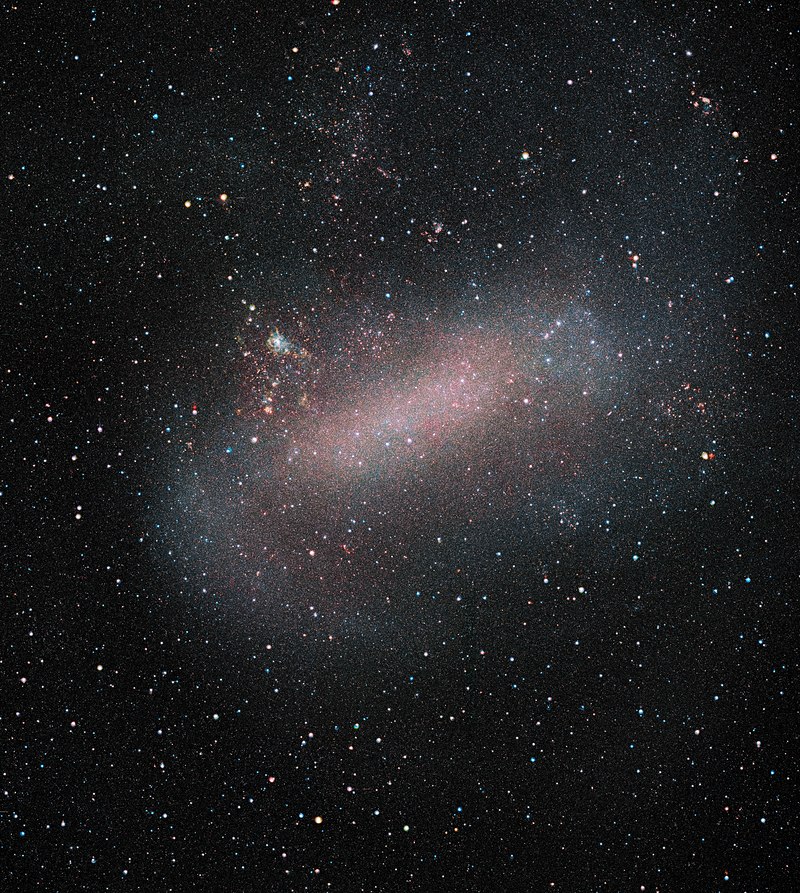
|
A sample of 44 blazar candidates behind the Magellanic Clouds, including 27 flat spectrum radio quasars (FSRQs) and 17 BL Lacertae–type objects (BL Lacs), were selected and described by Żywucka et al. (2018). All objects in the sample were selected based on their radio, mid-infrared, and optical properties. Now, the analysis of the blazar candidates is extended with modelling of optical light curves provided by the Optical Gravitational Lensing Experiment (OGLE).
More... |
| December: ROGUE I: a catalogue of Radio sources associated with Optical Galaxies and having Unresolved or Extended morphologies |

|
How small and young radio sources evolve into large structures? Do all of them grow to
large sizes? How the apparence of the radio source depends on the power of central nucleus,
environment, and projection? How is the radio activity of active galactic nuclei (AGN)
related to activity in other ranges of the electromagnetic spectrum? To answer all these and
many other questions large catalogues of properly identified and classified radio sources are
needed. Such information is now provided by the ROGUE I catalogue, produced and published by
female researchers from the Astronomical Observatory of the Jagiellonian University.
More... |
| November: Ionized Iron Line in Radio Galaxy CGCG 292–057 |

|
There is presence of ionized atoms in the centre of CGCG 292-057. At the nucleus of the
galaxy, there is a nuclear spectrum with atoms such as O+, N+,S+ – so-called Low-Ionization
emission line-region (LINER). The morphology of CGCG292-057 has multiple components and
plasma materials of various sizes. It has outer lobes extending up to ~230 kpc and inner
lobes up to ~20 kpc. Active galaxies used to have two opposite jets emanating from the
central engine, up to few millions years old, that are intermittent in nature. In the case
of CGCG 292−057, one can potentially witness all the aforementioned processes at work,
imprinted in the complex morphology of its radio jets and lobes, as well as in its host galaxy.
More... |
| October: Complex Structure of the Eastern Lobe of the Pictor A Radio Galaxy |
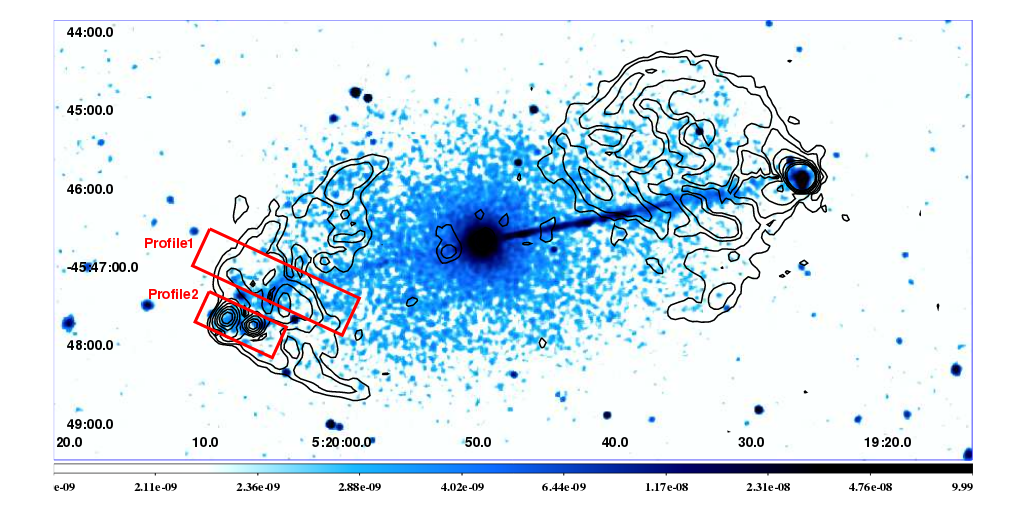
|
Pictor A, classified as a Broad-Line Radio Galaxy with the “classical double” (Fanaroff-Riley type II) large-scale radio
morphology and located at the redshift z=0.035, is one of the most prominent radio galaxies in the sky and the prime target
for detailed multiwavelength investigations in the recent decades, from radio to the X-ray ranges. Now, JU astronomers
present the detailed analysis of the distinct X-ray emission features present within its Eastern radio lobe utilising the
data obtained from the Chandra X-ray Observatory.
More... |
| September: X-ray magnifying glass enhances view of distant black holes |
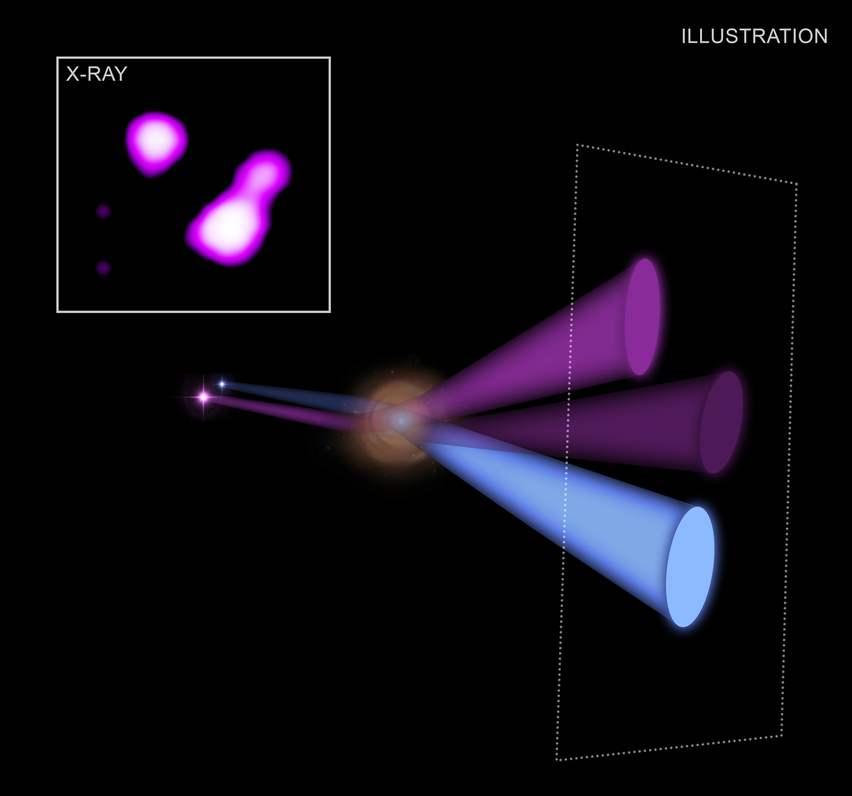
|
By taking advantage of a natural lens in space, astronomers have captured an unprecedented look at X-rays
from a black hole system in the early Universe. This magnifying glass was used to sharpen X-ray images, for
the first time using NASA’s Chandra X-ray Observatory. It captured details about black holes that would
normally be too distant to study using existing X-ray telescopes.
More... |
| August: J0028+0035 - a fidget spinner like radio galaxy |
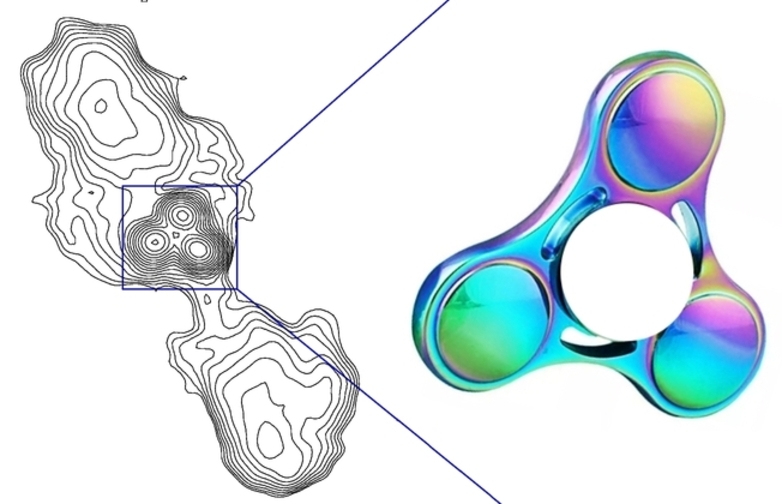
|
The radio galaxy J0028+0035 has three components in the centre, thus its morphology resembles a fidget spinner.
The central component on the left is a distant blazar, not connected physically with the other objects visible on
the map. The other two components on the right, which can be seen better in the right-hand side image, constitute
a small radio galaxy consisting of a core and two lobes. J0028+0035 belongs to a rare class of restarting radio
galaxies with two pairs of lobes, involving components that emerged from two different cycles of activity of the
central object.
More... |
| July: Kinematics of coronal mass ejections in the LASCO field of view |
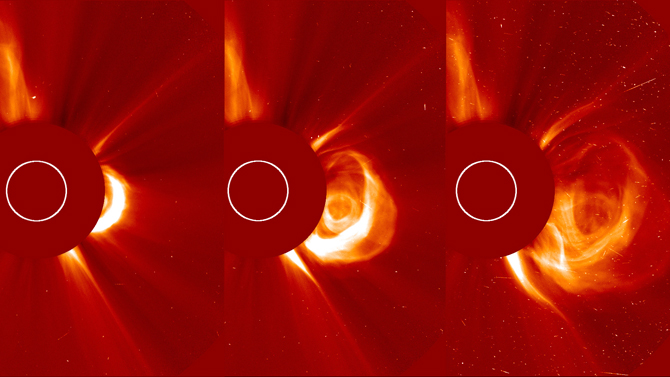
|
An accurate understanding of the propagation of coronal mass ejections (CMEs) is crucial in the prediction of space weather. CMEs generate geomagnetic storms causing catastrophic damages to power grids on Earth and are serious radiation threat to satellites on low-Earth orbit and their crew during spacewalks. Basic parameters such as their velocity and acceleration varying with time and heliospheric distance away from the Sun gives researchers the opportunity to predict their arrival time in the vicinity of the Earth. In this paper, we analyze the trend of this parameter in regards to the solar cycles 23 and 24.
More... |
| June: Nickel atoms detected in the cold gas around interstellar comet 2I/Borisov |
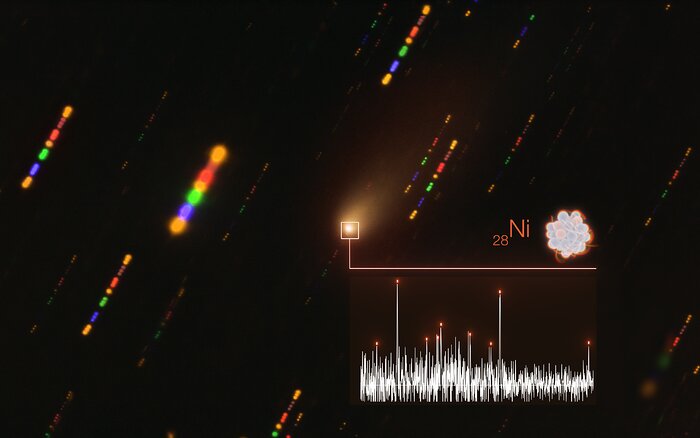
|
Unbound nickel atoms and other heavy elements have been observed in very hot
cosmic environments, including the atmospheres of ultra-hot exoplanets and
evaporating comets that ventured too close to our Sun or other stars. A new
study conducted by JU researchers reveals the presence of nickel atoms in
the cold gasses surrounding the interstellar comet 2I/Borisov. The team’s
finding is being published in Nature on 19 May 2021.
More... |
| May: LOFAR and the galaxies of the young Universe |
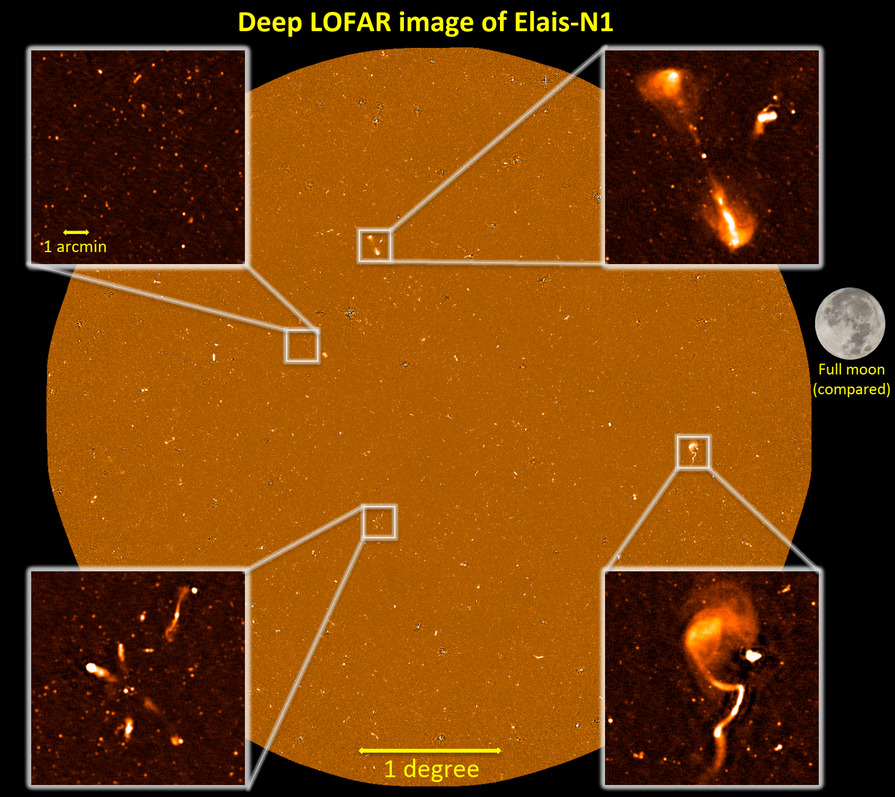
|
International team of astronomers, including scientists from the Astronomical Observatory of the Jagiellonian University, has published the most accurate map of the Universe at low radio frequencies, created with the use of the European LOFAR radio telescope. As a result, it was possible to detect the faint radio glow from the stars that exploded as supernovae in tens of thousands of ancient galaxies spread out to the farthest regions of the Universe.
More... |
| April: A Multi-wavelength look at a sample of Compact Radio Galaxies |
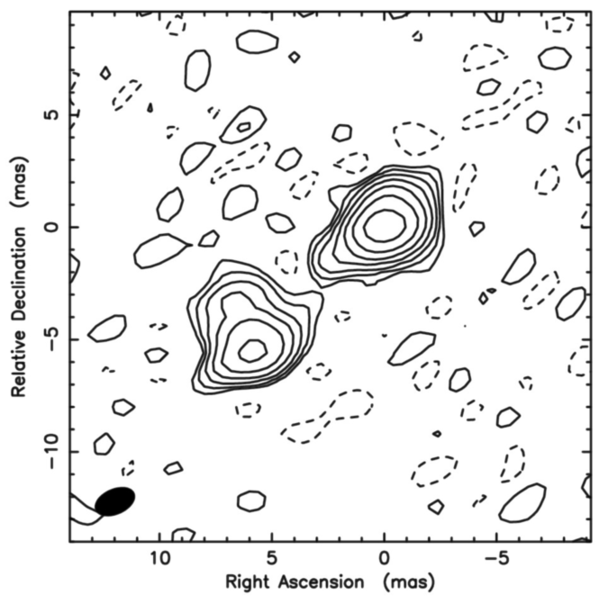
|
Compact radio galaxies are a particularly interesting class of active galactic nuclei (AGN), with newly born
radio structures (jets and lobes) fully confined within their host galaxies. They can provide information
on the processes that lead to the production of relativistic jets, as well as insight into the complex
dynamics of feedback between evolving supermassive black holes and interstellar medium. Recently work was
published by an international group, led by researchers at the JU Astronomical Observatory, on the infrared
X-ray properties of a sample of 29 of this type of galaxy.
More... |
| March: Can we observe that the magnetic field heats the surrounding gas? |
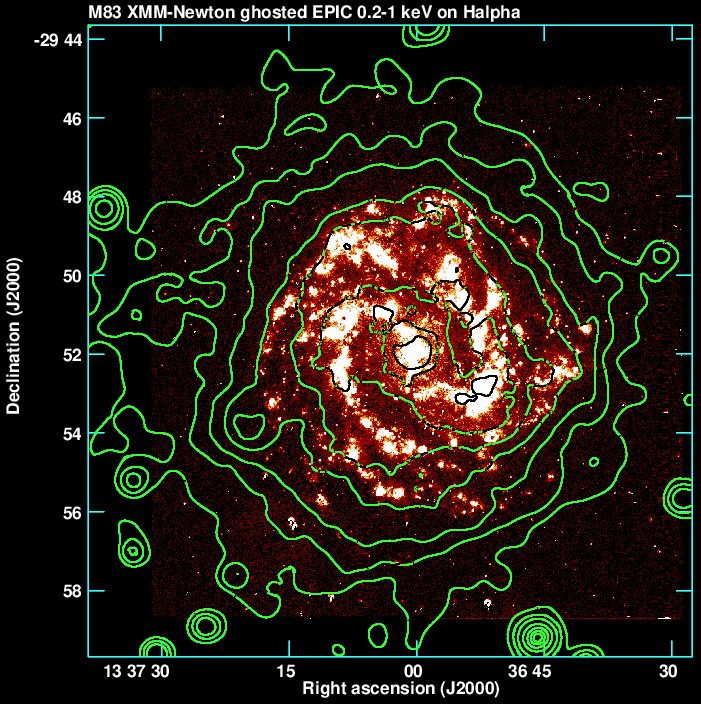
|
Magnetic fields can do a lot of things. They are even believed to govern star formation, by supporting the contraction of gas. Not to mention, that
the galactic evolution often depends on them. They are practically everywhere. And the gas is also everywhere. Would it be possible, then, that the
magnetic fields can heat the gas that surrounds them? To find out, a study is being performed that combines analyses of both X-ray and radio
observations of a sample of quite extraordinary spiral galaxies. One of them is NGC 5236, better known to sky enthusiasts as M83.
More... |
| February: Freely falling bodies in standing-wave spacetime |
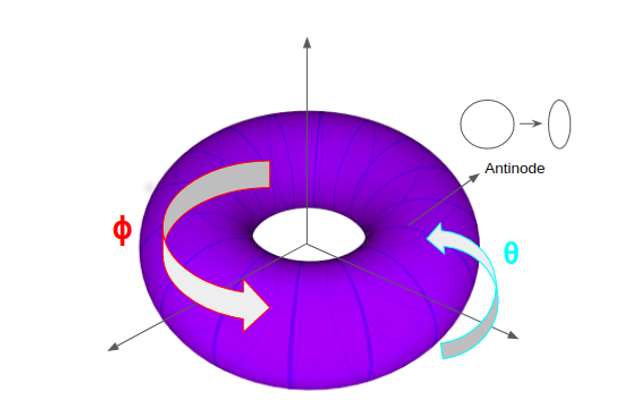
|
The phenomena of standing waves is well known in mechanical and electromagnetic setting where the wave has the
maximum and minimum amplitude at the antinodes and nodes, respectively. In context of exact solution to Einstein
field equations, we analyze a spacetime which represents standing gravitational waves in an expanding Universe.
More... |
| January: Optical Luminosity-Time correlation for more than 100 GRBs |
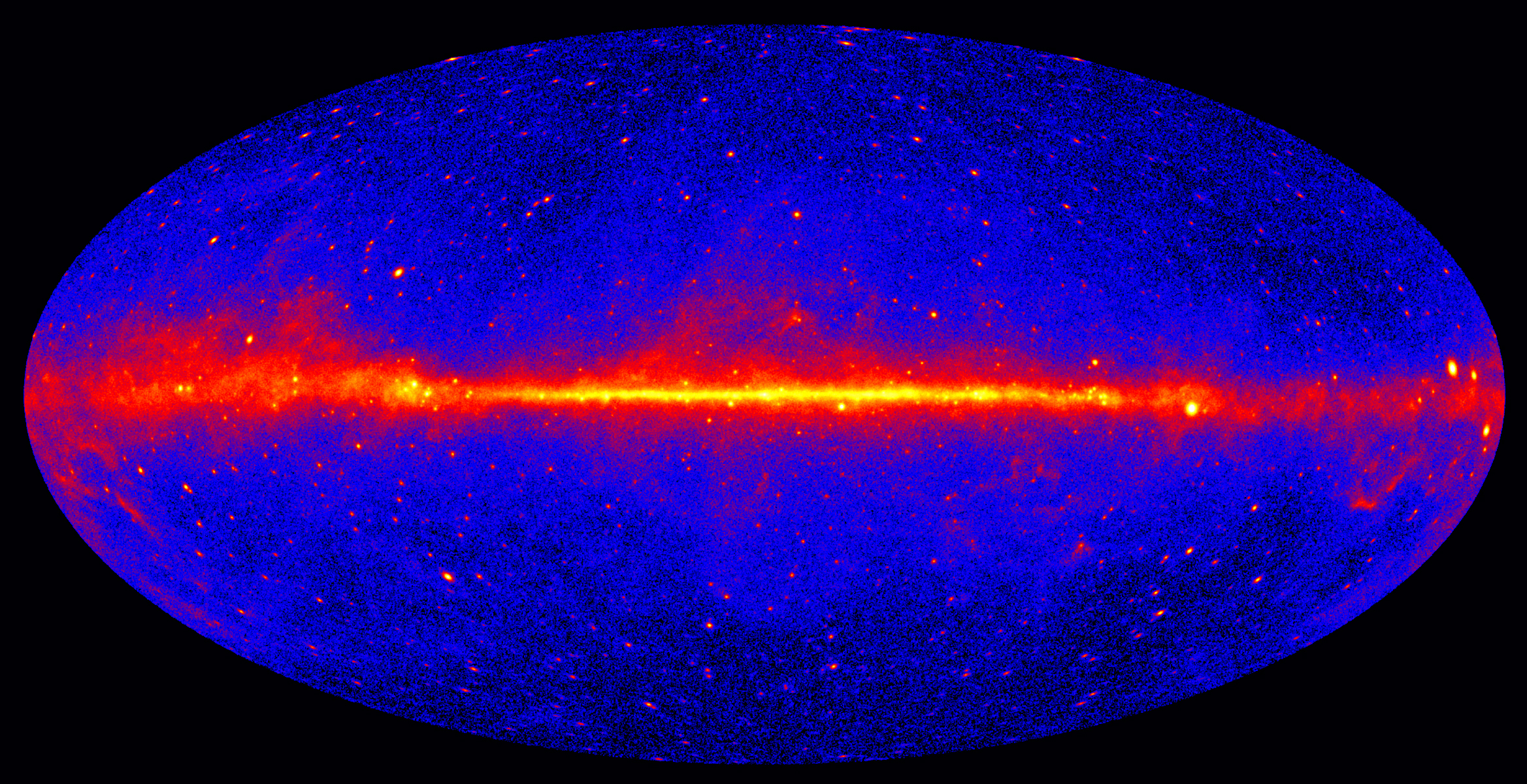
|
New correlation has been discovered in optical observations of gamma-ray bursts (GRBs) and
may be the key to using GRBs as cosmological distance indicators. Maria Giovanna
Dainotti (Jagiellonian University, RIKEN iTHEMs, Space Science Institute) and Samantha Livermore
(physics major at Tufts University) worked with the large international team to gather
a sizable sample and conduct their rigorous statistical analysis. This research features the
largest sample of optical plateaus in the literature to date.
More... |
| December: The rotation of Comet NEOWISE |
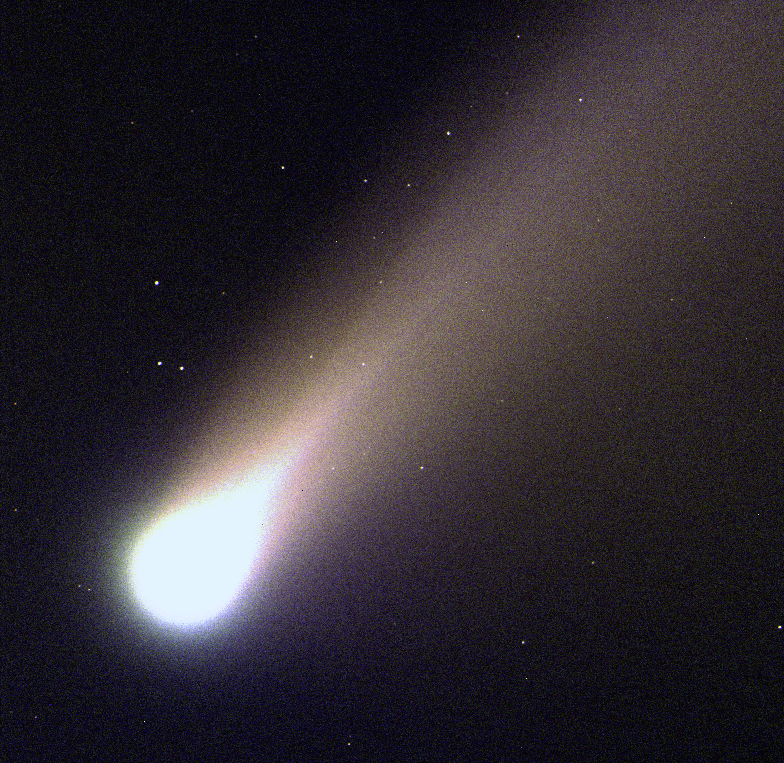
|
Comet C/2020 F3 (NEOWISE) embellished the 2020 summer sky. It left many memories and beautiful photos, but, most of all, valuable scientific data. The international Gemini Observatory in Hawaii was used to observe the comet by the team led by Michał Drahus from the JU Astronomical Observatory in Krakow. The obtained observational data allowed for a detailed study of the material evaporated from the comet as it traveled through the inner regions of the Solar System.
More... |
| November: Gamma-Ray Burst associated with Kilonovae: ambushing the Standard Candle in its own nest |
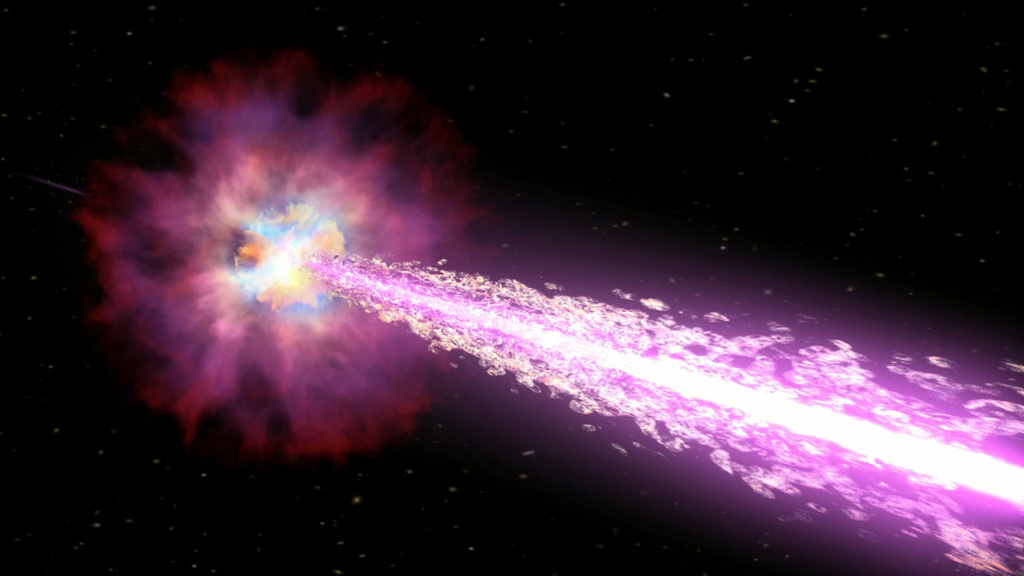
|
Gamma-Ray Bursts (GRBs) are the most luminous and explosive transient phenomena in the Universe after the Big Bang, but they are still puzzling phenomena regarding their emission mechanism even after more than 50 years from their discovery. A powerful tool for characterizing and classifying GRBs to allow them to be used as tracers of the expansion history of the Universe and to understand their mysterious and debated physical mechanisms has been recently presented by an international team of researchers led by Dr. hab. Maria Dainotti, Assistant Professor at Jagiellonian University, Poland and concurrently serving as Affiliate Research Scientist at Space Science Institute, in Boulder, Colorado.
More... |
| October: GRBs as Standard Candles: observations vs. theory |
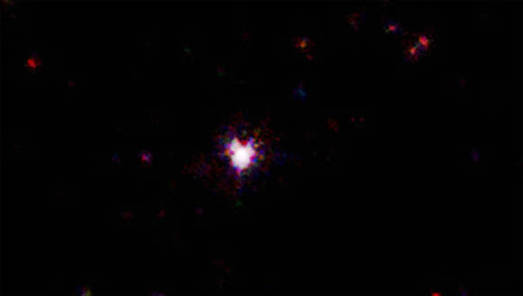
|
A study presenting the most comprehensive analysis of Gamma-Ray Bursts (GRBs) detected by the Neils Gehrels Swift Observatory to this day has been presented in a new article accepted in the Astrophysical Journal Supplements Series. The analysis was performed by an international team led by Dr. Maria Giovanna Dainotti, assistant Professor at Jagiellonian University concurrently serving as affiliated Scientist at Space Science Institute in Colorado, and as a mentor of the Science Undergraduate Laboratory Internships (SULI) program at Stanford University. More... |
| September: The most widespread, regular magnetic field in the Universe |
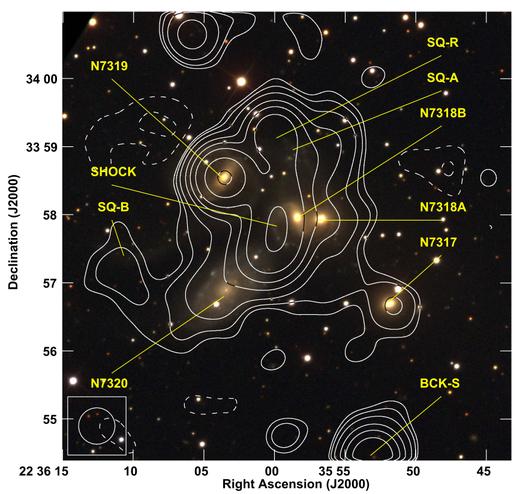
|
A team of scientists from the Jagiellonian University and CSIRO has published an article that describes a vast, magnetised structure found in a small, compact galaxy group – the Stephan’s Quintet. It seems that we are facing some kind of a magnetic „screen”, with an extent of at least 200 000 on 130 000 on 65 000 light years. It is the largest known, regularly magnetised structure in the Universe. More... |
| August: Non-interacting coronal mass ejections and solar energetic particles near the quadrature configuration of Solar TErrestrial RElations Observatory |
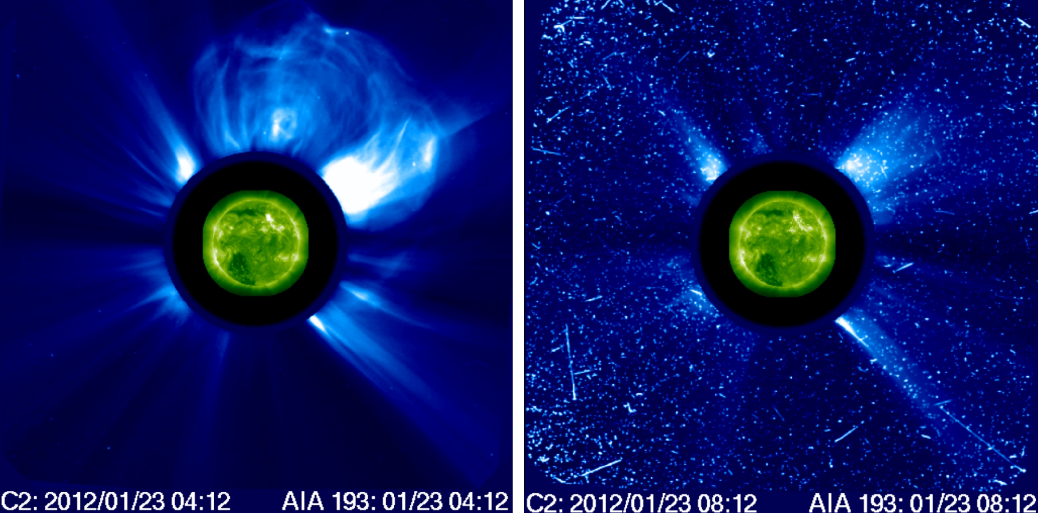
|
Space weather is mainly controlled by the
strong magnetic storms and particle storms which are caused by the enhanced
fluxes of protons and ions. These accelerated plasmas are known as solar energetic particles (SEPs). The generation of SEP is mainly due to two
phenomenon, impulsive SEP events caused by magnetic reconnection manifested as solar flares, and gradual SEP events accelerated by strong shocks
associated with coronal mass ejections (CMEs). In this paper we
have shown that our method of employing so-called instantaneous speed (maximum speed and the CME speed and Mach number at SEP peak flux) offers
better correlation than the average speed. In addition, we observe poor correlation between fluxes of SEPs and Flares, which
support the hypothesis that energetic particles observed in the considered energy range are predominantly accelerated by CME shock. More... |
| July: The discovery of high-energy gamma rays from the jet of the active galaxy Centaurus A |
.jpg)
|
On June 17, journal Nature published the paper of researchers from the international
H.E.S.S. Observatory,
presenting the discovery of high-energy gamma emission from the relativistic beam, or "jet", of the
nearby active galaxy Centaurus A (Cen A). This important astronomical discovery was made with
participation of Polish scientists, including the team from the Astronomical Observatory of the
Jagiellonian University. More... |
| June: Pulsating blue subdwarfs and planets which are not there |
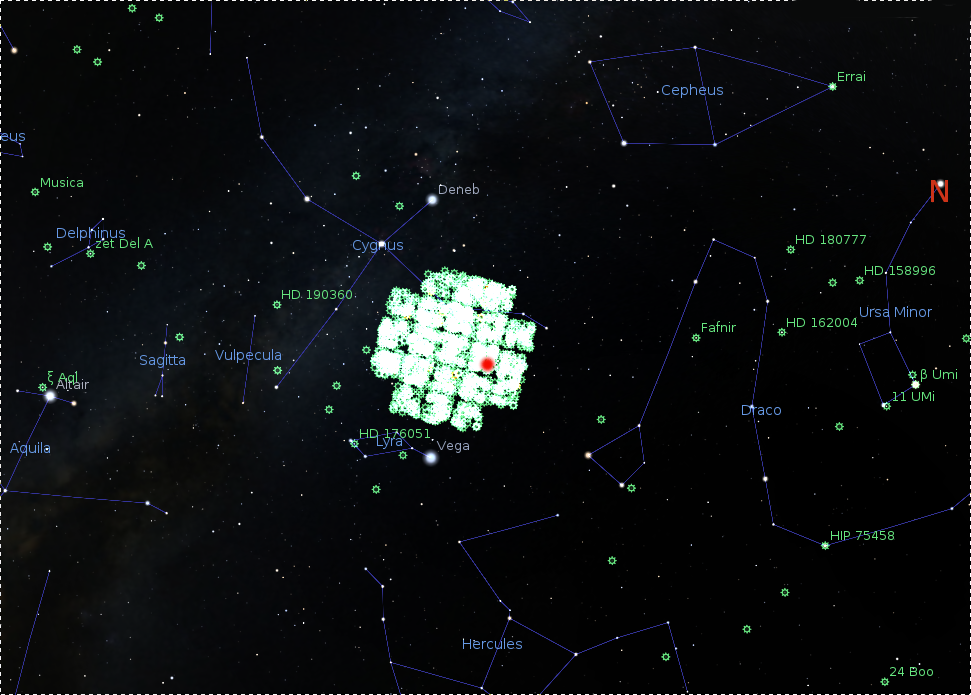
|
In 2011 and 2014, reports appeared that two pulsating sdBV stars observed by the Kepler Space Telescope,
KIC 5807616 and KIC 10001893, could be circled by extrasolar planets on tight orbits. However, a new
analysis of the putative planetary signatures found in the light curves of these stars shows that there
are no planets around them. The research involved professor Jerzy Krzesiński from the Astronomical
Observatory of the Jagiellonian University in Kraków and his PhD student Adam Blokesz from the Pedagogical
University of Kraków. More... |
| May: Spitzer Telescope test Einstein Gravity: repeated explosions near a black hole give a clue |

|
A very recent observation of a predicted flaring from a distant galaxy by Spitzer Space Telescope has firmly established the
existence of a massive black hole pair emitting nano-Hertz gravitational waves which should assist the on-going international
efforts to directly detect such waves. Spitzer observation is also constraining a unique property of black holes, explored by
Stephen Hawking and collaborators. More... |
| April: Examination of microvariability of the flux and the polarization of blazars in the optical band |
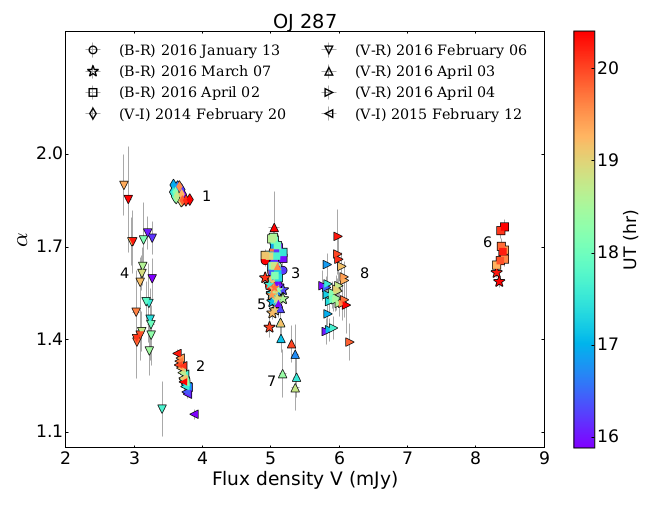
|
Active Galactic Nuclei (AGNs) consists of galaxies with extremely bright nucleus, so much so, that they usually
outshine the light from other galaxy parts such as arms or bulges. The reason behind intense power of AGN is believed
to be that at the centre of galaxy a super massive black hole (SMBH) is accreting matter from its vicinity. Sometimes,
such systems are known to erupt powerful, narrow beam of high velocity charged particles. If one happens to view such
a systems along the line of sight of these eruptions (jets) are called blazars. The emission from blazar jets is Doppler
boosted, leading to extreme luminosities and flux variability and apparent superluminal motion shown by the ejecta. More... |
| March: The Nature of γ-ray Variability in Blazars |

|
Blazars shine predominatly in high energy emission, e. g. X-ray and gamma-ray wave bands. It is widely believed
that the high energy emission is produced via synchrotron and inverse-Compton processes at the relativistic shock
waves which propagate along the blazar jets or magnetic reconnection processes in case of highly magnetized jets.
However, in spite of the collaborative efforts of several modern space and earth bound telescopes, the details of
the mechanisms and the exact location of the production of the high energy emission, in reference to the
central engine, remain elusive. More... |
| February: CSO radio sources and efficiency of their jets |
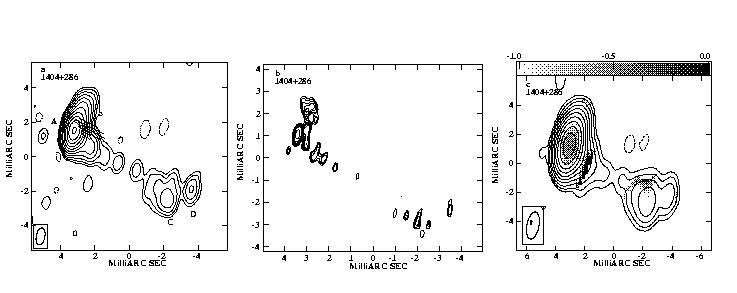
|
The international team headed by astronomers from the Jagiellonian University has published detailed
research on the jet production efficiency in a sample of 17 selected young radio galaxies, for which the
observed luminosities of their jets, radio lobes and accretion disks seem to correspond to the same
episode of the central activity of their parent galaxies. More... |
| January: The catalogue of giant radio sources |
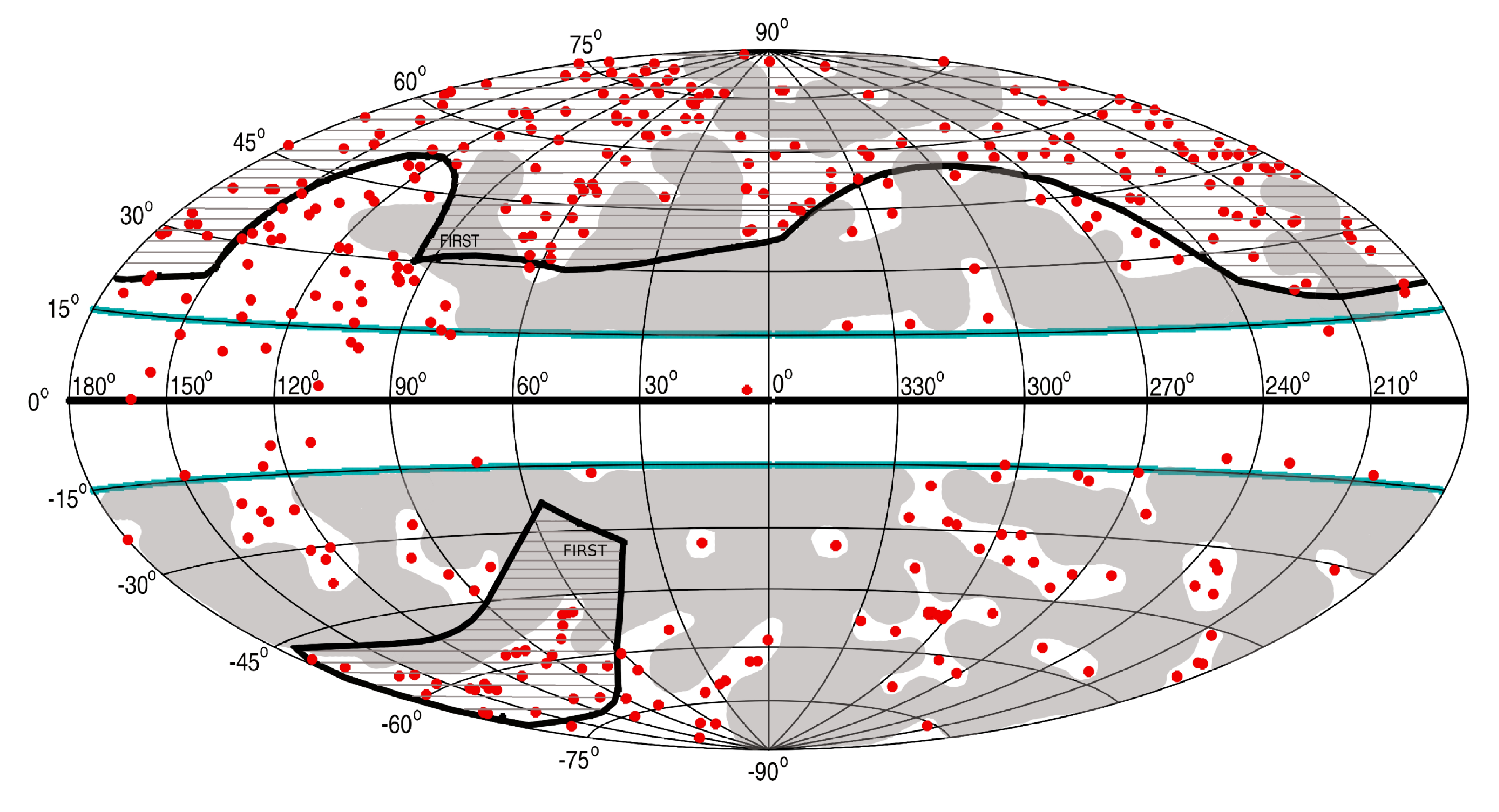
|
Giant radio sources are a peculiar class of objects due to the extremely large (> 0.7 Mpc) sizes of their observed radio
structures. It is believed that this is relatively rare feature, because only ~5% of all known radio sources exceed this
size. The reasons why some radio sources have grown to such large sizes are not fully explained, however detailed multiwavelength
studies have progressed significantly our knowledge about the nature of giants. More... |
| December: First detection of gamma-ray burst afterglow in very-high-energy gamma light |
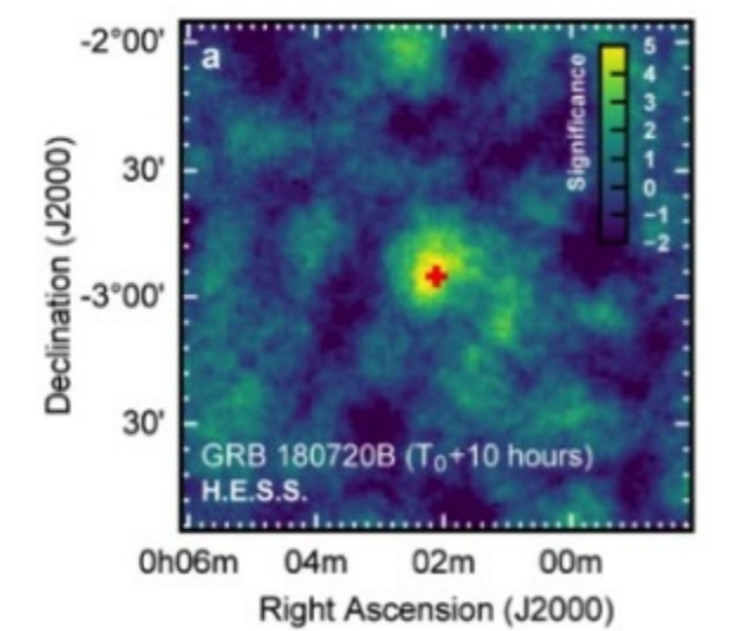
|
After a decade-long search, scientists have for the first time detected a gamma-ray burst in very-
high-energy gamma light. This discovery was made in July 2018 by the H.E.S.S. collaboration
using the huge 28-m telescope of the
H.E.S.S. array in Namibia. Surprisingly, this Gamma-ray
burst, an extremely energetic flash following a cosmological cataclysm, was found to emit very-
high-energy gamma-rays long after the initial explosion. More... |
| November: Interstellar Comet with a Familiar Look |
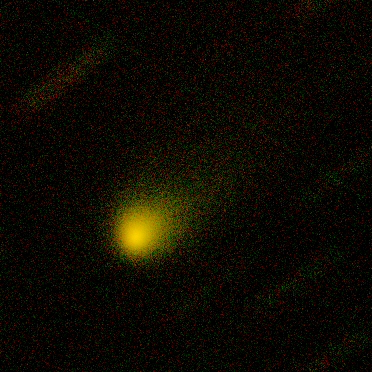
|
A new comet discovered by amateur astronomer Gennady Borisov is an outcast from another star system, yet its
properties determined so far are surprisingly familiar – a new study led by JU researchers shows. The team’s
findings are being published in Nature Astronomy on 14 October 2019. More... |
| October: Estimation of Arrival Time of Coronal Mass Ejections in the vicinity of the Earth |
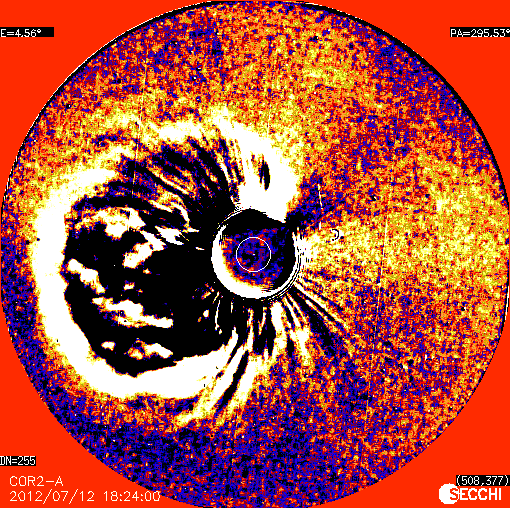
|
The arrival time of coronal mass ejections (CMEs) in the vicinity of the Earth is one of the most important parameters in determining space weather. An accurate model for prediction of travel time (TT) of CMEs directed towards Earth is important as they cause intense geomagnetic disturbances. Our study provides prediction model with lesser errors compared to previous methods. In addition this gives us a better understanding of the kinematics of CMEs. More... |
| September: Needle-like structures on positively charged lightnings |
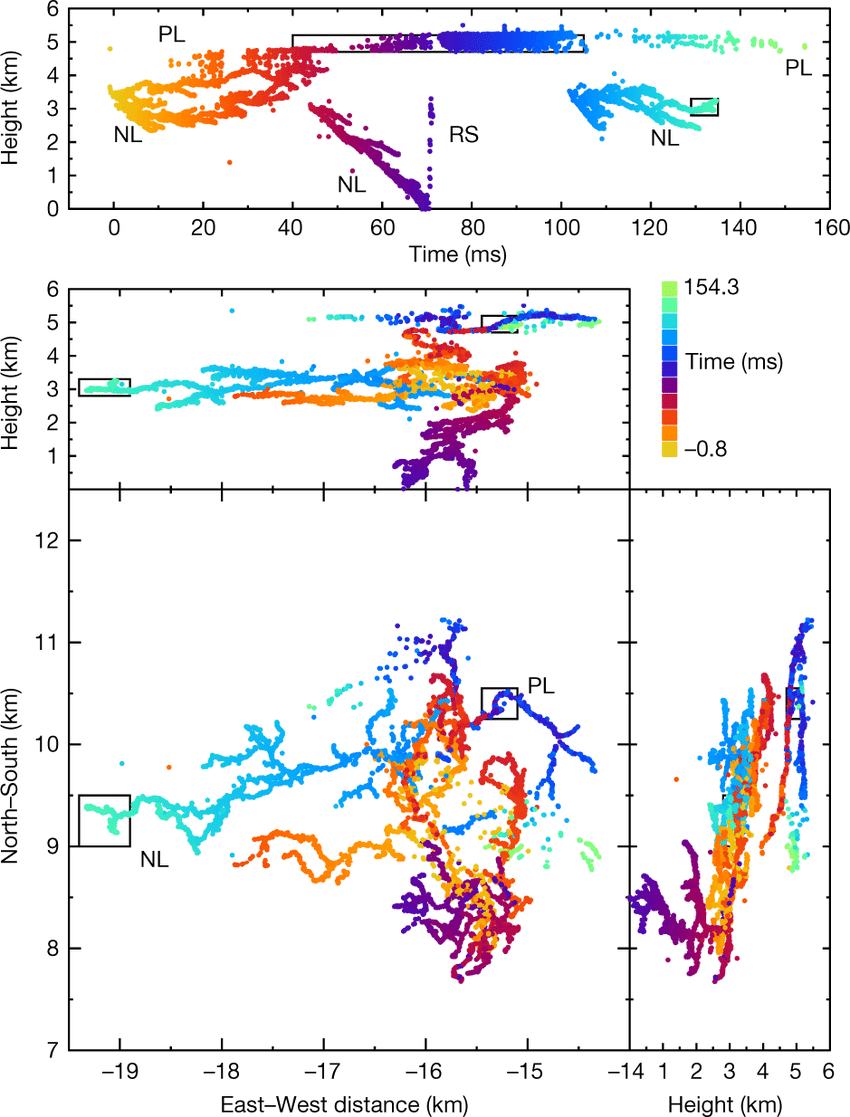
|
Thunderbolts occuring in Earth’s atmosphere are dangerous yet still poorly understood natural phenomenon. Typical lightning forms a network of plasma channels propagating away from the initiation point with both positively and negatively charged ends—so-called positive and negative lightning leaders. More... |
| August: Rhythmic oscillations of the blazar Markarian 501 |

|
Dr. Gopal Bhatta from the Jagiellonian University in Kraków has detected transient rhythmic oscillations
in the gamma-ray emission from the
blazar Markarian 501. The discovery could be helpful in improving our understanding of the most energetic processes
taking place in the universe. More... |
| July: Signatures of UV radiation around low-mass protostars in Serpens |
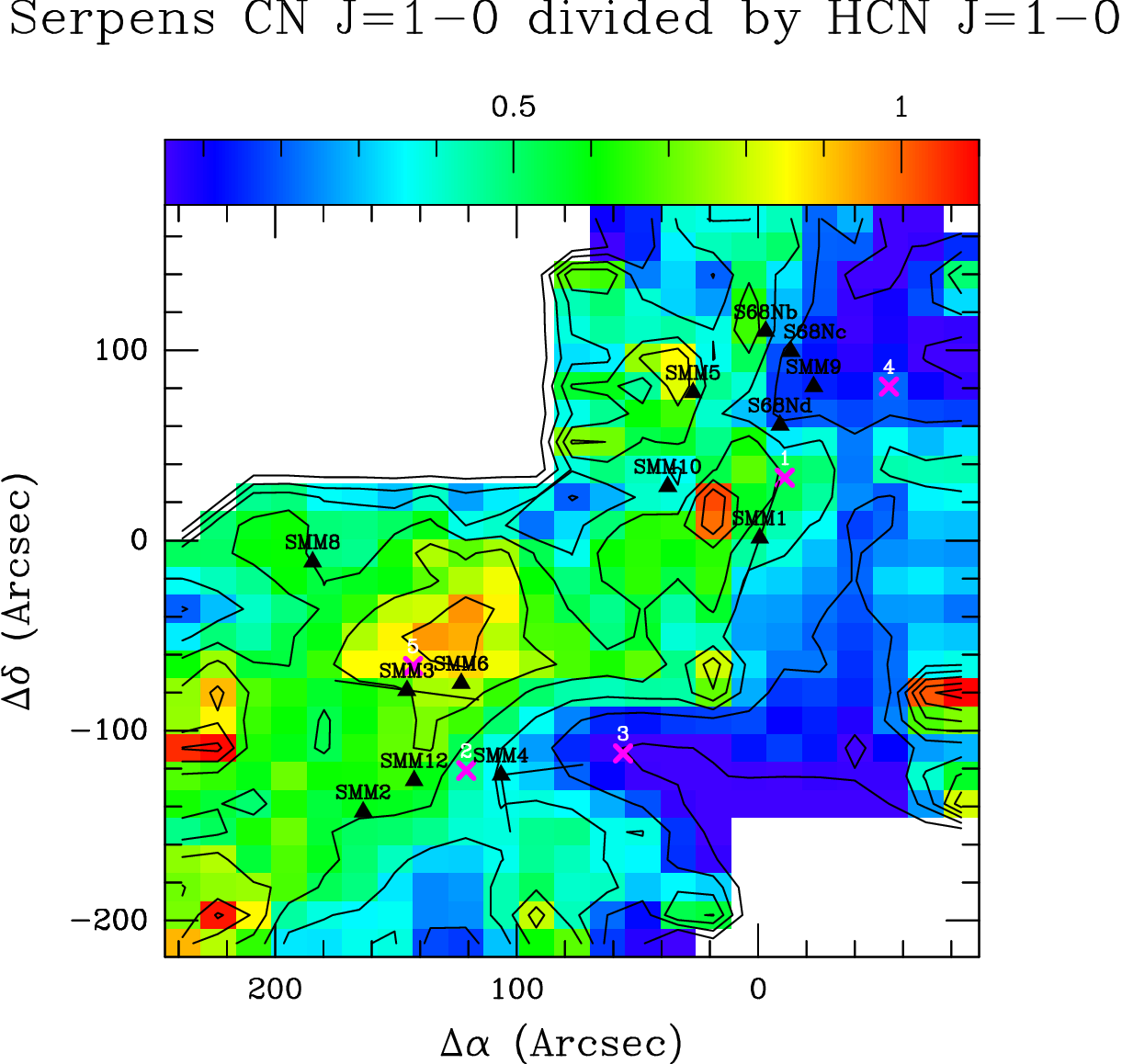
|
A new-born protostar forms in dense core deep inside molecular cloud.
Molecular cloud is characterised by high extinction in the optical
range so observations at long wavelengths are necessary. In particular, submillimetre spectra include
rotational lines of key molecules which are useful tracers
of physics and chemistry around low-mass protostars. The column densities of HCN and CN molecules can be determined with the RADEX radiative
transfer code. This information can be compared with an astrochemical model in order to characterise the strength of the UV radiation. Thus,
we gain new understandings of chemical and physical processes around low-mass protostars. More... |
| June: Dusty galaxies from the AKARI All Sky Survey |
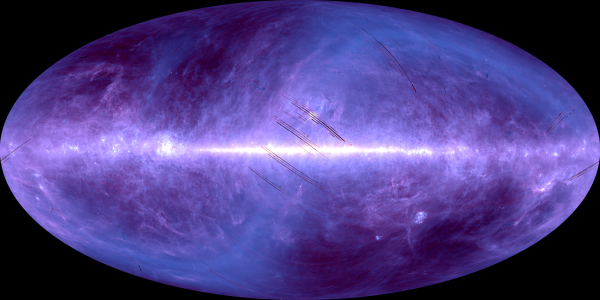
|
Recent studies show that optically selected AGNs often follow the far infrared-to-radio correlation as tightly as star forming
galaxies. Most galaxies containing AGNs have their far infrared-to-radio flux ratios indistinguishable from those of the star
forming ones, with the exception of Seyfert galaxies. To study this dependence more accurately, international team led by
astronomers from National Centre for Nuclear Research and Jagiellonian University used the newest measurements from the AKARI
Far-Infrared All Sky Survey to cross-correlate the AKARI data with the NVSS radio catalogue at 1.4 GHz. More... |
| May: New method of constructing inhomogeneous cosmological models |
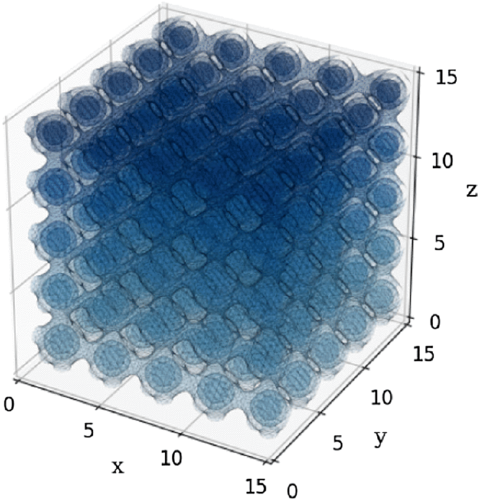
|
Studies of inhomogeneous cosmological models are an actively developed branch of
general relativity and cosmology. By developing new techniques for solving the physically motivated issues of Einstein's theory of gravity, we
expand our knowledge of the Universe with unknown phenomena and set future directions for research. More... |
| April: Gamma-Ray Bursts zoo sorted in 3D |
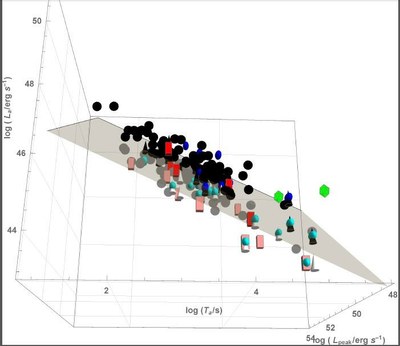
|
A powerful tool for characterizing and classifying gamma-ray
bursts (GRBs) to allow their use as tracers of the expansion history of the universe has recently been presented by an
international team of researchers led by Dr. Maria Dainotti, assistant Professor at Jagiellonian University, Poland and concurrently
serve as Chretienne Fellow appointed by the American Astronomical Society at Stanford University. The work, which has been published
in the Astrophysical Journal, is a statistical analysis of the properties of the yet mysterious GRBs, aimed at determining a sub-group
of GRBs and investigating the physical origin of these systems. More... |
| March: Compact galaxy groups observed with LOFAR radio interferometer | ||
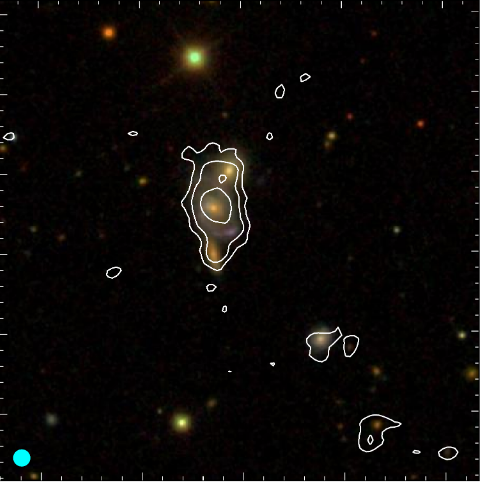
|
LOFAR Two-metre Sky Survey (LoTSS) has detected
thousands of new galaxies. International team — including scientists from the Astronomical Observatory of the
Jagiellonian University — used this survey to identify the groups of galaxies from the
Hickson Compact Groups and Magnitude
Limited Compact Groups samples that emit at the low radio frequency of 150 MHz. Their radio emission was then
characterised and the newly obtained results were compared to earlier observations and theoretical predictions for the groups. More... |
|
| February: Stars, galaxies and quasars from the Infrared WISE Survey | ||
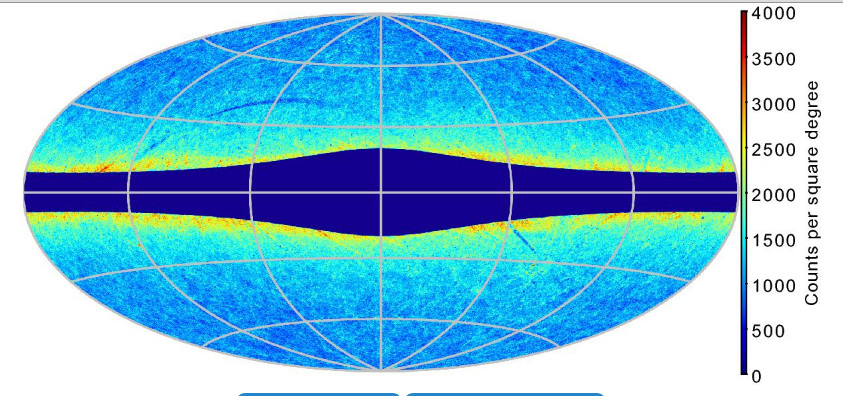
|
The Wide-field Infrared Survey Explorer (
WISE) satellite has detected hundreds of millions of new infrared sources. Classifying them reliably is, however,
a very challenging task. Simple colour cuts are often not sufficient; for satisfactory levels of completeness and purity,
more sophisticated classification methods are needed. A team of astronomers from Jagiellonian University and other Polish
research centers is developing new, automated methods of source classification in full-sky WISE data. More... |
|
| January: Possible link between relativistic jets and accretion disk found in the giant quasar 4C+74.26 | ||

|
4C+74.26 is a quasar located about 1.4 billion light years away from us - one of the few quasars with giant radio lobes
spreading across millions light years. An team of researchers led by Dr. Gopal Bhatta from the Jagiellonian University in
Kraków studied the source using multifrequency observations from the ground and space based telescopes. The team discovered
that the optical emission delayed behind radio emission by ~250 days. The authors proposed that the delay may indicate a
scenario in which flux modulations arose due to magnetic disruptions at the innermost regions of the accretion disk. Such
a lag between two emission bands is relatively rarely observed and it could help in understating the most challenging
issues in modern astrophysics. More... |
|
| December: Kordylewski Clouds – dust moons of the Earth-Moon System | ||

|
At the end of October 2018, an interesting set of publications, by a team of Hungarian scientists, were published
in the Monthly Notices of the Royal Astronomical Society. Judith Sliz-Balogh, Andras Bart and Gabor Horvath reported their observations
of the Earth’s dust moon. The initiator of the search for these dusty moons of Earth was doc. Kazimierz Kordylewski from the Astronomical
Observatory of the Jagiellonian University. More... |
|
| November: Blazars observed behind the Magellanic Clouds | ||

|
Identification of AGNs in dense stellar fields such as the Large and
Small Magellanic Clouds (MCs) is extremely challenging due to large densities of stars in the interstellar medium. Among the 758 MQS quasars
and 898 unidentified objects, a sample of 44 blazar candidates were identified with respect to their radio, optical, and
mid-infrared properties. The newly selected blazar candidates possess the long-term multi-colour (I nad V filters) photometric
data from the OGLE, multi-colour mid-infrared observations, and archival radio data for at least one frequency. Moreover, nine blazar
candidates have radio polarization data. The results are accepted by Astrophysical Journal. More... |
|
| October: SBS B1646+499: black hole with a jumbled past | ||

|
Blazars constitute a particular class of so-called active galaxies (AGNs). These exotic objects emit huge amount of energy.
Blazars host very masive black holes in their centers, surrounded by accretion discs and toruses. Their high-energy radiation is mostly emitted in
collimated streams called jets. The emission of such objects is dominated by the relativistically boosted, non-thermal emission of the jets observed at
a small angle to the observer on Earth. In the case of blazar SBS B1646+499, the galaxy activity phase associated with the jet production has already
occurred at least twice. The results are accepted by Astrophysical Journal. More... |
|
| September: Detection of Periodic Radio Signal from the Blazar PKS 0219-164 | ||

|
PKS 0219-164 (z=0.7) is a BL Lac source that been detected over a broad range of the electromagnetic spectrum including radio, infra-red, optical,
X and gamma rays. The accurate position of the source at radio frequency (2700 MHz) and its optical counterpart was measured in 1977.
The decade-long 15 GHz radio observations of the blazar PKS 0219-164 from the 40-m telescope OVRO
were recently analyzed. Study revealed a strong repeating signal with a periodicity of ∼270 days. The results are published in
Astrophysical Journal More... |
|
| August: TXS 0506+56: discovery of an energetic cosmic neutrino source due to very high energy gamma ray observations | ||

|
On September 22nd last year the Ice Cube Neutrino Observatory at the South
Pole detected a high energy neutrino with a likely cosmic origin. A single neutrino does not suffice to identify its source. Very soon after
its detection telescopes working at different wavelengths of the electromagnetic spectrum started to observe the possible location it came from.
The results are published in Science. More... |
|
| July: First long term all-frequency power spectral analysis of OJ 287 | ||
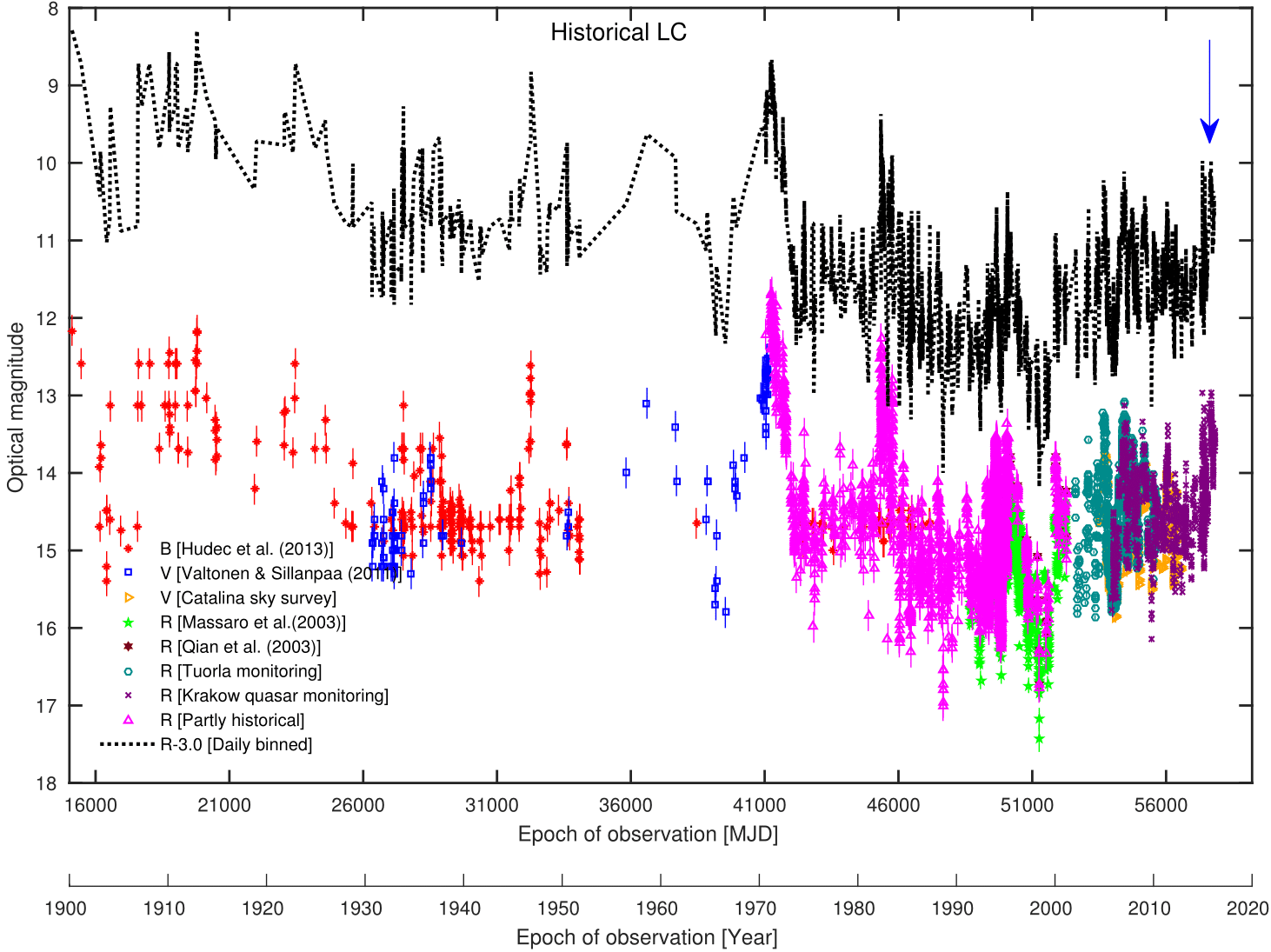
|
The international team headed by Dr Arti Goyal from the Astronomical Observatory of the Jagiellonian University conducted
the first long term all-frequency power spectral analysis for OJ 287, using also the data from Kepler satellite and constructing the
optical variability power spectrum without any gaps. The results are published in The Astronomical Journal. More... |
|
| June: In-depth measurements of the interstellar asteroid ‘Oumuamua unveil its turbulent past and verify previous reports | ||

|
‘Oumuamua is the first astronomical object known to science to have entered the Solar System from the interstellar space, having been ejected from its
original planetary system. Using the giant Gemini North telescope in Hawaii, a team of scientists led
by astronomers from the Jagiellonian University in Kraków conducted an in-depth study of the body. Among other findings, the study revealed that ‘Oumuamua is
“tumbling” through space, consistent with a collision in the distant past, as well as verified and expanded upon a number of previous reports. The results
have just appeared in the latest issue of Nature Astronomy. More... |
|
Contact:
|
Elżbieta Kuligowska Astronomical Observatory of the Jagiellonian University Elzbieta.Kuligowska [at] oa.uj.edu.pl |


